DornsifeSPH
Facing this Challenge
As COVID-19 continues to disrupt global health, Dornsife remains focused and committed to being part of a meaningful and effective response.

MAGAZINE 20 20 THE MAGAZINE FOR DREXEL UNIVERSITY’S SCHOOL OF PUBLIC HEALTH VOL/

FOREWORD IN PHOTOGRAPHS
Members of the Dornsife School of Public Health faculty and staff assisted in the planning of a COVID-19 drive-thru testing facility at Citizens Bank Park in South Philadelphia. Several students and faculty also volunteered at the site, which served vulnerable individuals over the age of 50.

March 2020
During the last two weeks of March, shortly after stay-at-home orders were issued, noted Philadelphia photographer Jeff Fusco (safely) visited campus and traveled around the city to see what was going on.
From University City campus to neighboring West Philadelphia to Citizens Bank Park to Chinatown, here’s what the city of Philadelphia looked like.
-Alissa Falcone
01 20 20 VOL/
Jeff Fusco Photographer

02 FOREWORD IN PHOTOGRAPHS
As the pandemic evolved and Drexel University shut its doors in early spring, 33rd and Market, an intersection typically bustling with students, staff, faculty, and community members, is seen empty.

lone pedestrian crosses at 34th and Market, another intersection previously packed with people and food trucks.

03 20 20 VOL/
A

04 FOREWORD
IN PHOTOGRAPHS
Neighboring Drexel University, 30th Street Station, which houses the third-busiest Amtrak station in the U.S., is photographed with very few commuters and travelers.

05 20 20 VOL/
Before COVID struck, Dean Diez Roux prepares to announce the winners of Dornsife’s first Case Competition which was one of the School’s last large in-person gatherings on campus in 2020.
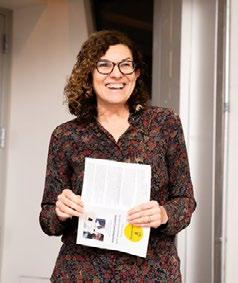
The world has faced a pandemic, something that public health experts have been talking about and even preparing for a long time, and yet I venture to guess that few expected that it would actually happen in our lifetimes. As cases and deaths increased in different places and at different times, we struggled (and still struggle) to get the right data and to leverage the public health infrastructure to choose the right policies and evaluate their impacts. Epidemiology has become an everyday word, and epidemiologic concepts are discussed at length in the press, but at the same time we have seen science being questioned and manipulated for political gain.
The pandemic has already killed over a million people worldwide, and this number is likely an underestimate and will continue to increase. Many more have been hospitalized with severe disease. Many millions, especially the poor across the globe, have suffered the dire consequences not only of the infection itself but also the loss of their livelihoods. And yet in the midst of all this glimmers of hope have emerged: in a remarkable show of collective response to protect population health, activities across the world shut down to prevent transmission; societies came together to provide payments for those left without jobs; the CDC issued an order halting evictions as
a public health measure; air pollution and greenhouse gas emissions dropped precipitously across the globe; many cities became more walkable and cycling soared. At the same time the pandemic has made more visible than ever the unfairness and injustice inherent in our society: like so many other diseases the virus hit the poor, the marginalized and those affected by a long history of structural racism the hardest. The epidemiology of the pandemic became a mirror in which we can see our society reflected.
And then in June, the murder of George Floyd launched hundreds of thousands into the streets, fed up with inaction, calling for an end to a long, long history of racism against Black people in all its multiple manifestations. Health, of course, is in many ways a barometer of social justice. Martin Luther King Jr. said as much in his famous words, “Of all the forms of inequality, injustice in health is the most shocking and the most inhuman.” A growing movement coalesced in support of Black Lives Matter, a movement that many of us feel (and hope) will be sustained and powerful and that will generate real reckoning and real change. Across the United States, counties and cities have begun to declare racism the public health threat and the public health crisis that it is and that it has been for so long. The long tradition of public health scholarship (much of it by Black scholars and scholars of color) that has named racism as a cause of health inequities and documented its impacts is at last receiving the recognition and visibility it deserves.
Over the past eight months the Dornsife School of Public Health community has come together in many ways. We have continued to teach by pivoting quickly to remote delivery and have prepared for an unprecedented new academic year. Our research has not only continued but also expanded to encompass work on COVID-19 and especially inequities in COVID-19. Our faculty, staff and students have continued to support our health department and community groups all over Philadelphia as they deal with the many implications of the pandemic. We have come together building on Dornsife’s historical commitment to health as a human right and to diversity and inclusion to develop and implement an anti-racism action plan and support the vital scholarship, training and advocacy that we need to advance an anti-racist agenda.
In the midst of all this universities like ours struggled to identify the best path forward on issues ranging from the practical and mundane to the transformative: Should students return to campus? How can masking be enforced? Is periodic testing feasible and useful? How can we begin to dismantle structures that reinforce social injustice and become fully anti-racist in our practices and policies? There is much uncertainty and we are only at the beginning of what will be a long and difficult path. But what I have seen in our students, in our staff and in our faculty over the course of these last eight months gives me hope. I know that after reading these pages you will agree.
06 DEAN’S MESSAGE
The last eight months have been frightening, remarkable, revealing, discouraging, and motivating all at once.
Ana V. Diez Roux, MD, PhD, MPH
Dean and Distinguished University Professor, Epidemiology, Dornsife School of Public Health
STREET SCENE

4.2.20 One of the unanticipated and surprising consequences of the pandemic is that I have gotten to know the streets of my city, Philadelphia, like never before. At the height of the pandemic, I took long walks through the city. I wore a mask and avoided other pedestrians as much as possible, crossing the street or stopping to let them pass by, a sad routine that has become a hallmark of our social interactions, something that none of us would ever have imagined that we would be doing a year ago. —Ana V.
Diez Roux, MD, PhD, MPH
07 20 20 VOL/ 20 20 VOL/
: Number of Philly-based artists featured in this redesign issue

For the inaugural issue of the redesigned Dornsife SPH Magazine, we collaborated with several local artists, including awardwinning illustrator Jon Krause, to help bring these pages to life. “I was incredibly excited to be asked to collaborate on the relaunch of Dornsife SPH Magazine. It’s always an honor to illustrate for one of my hometown/ city 6 schools, especially considering the importance of the subject matter being covered,” Krause said.
Jeff Fusco photographer / jefffusco.biz
FOREWORD IN PHOTOGRAPHS
Jon Krause illustrator / jonkrause.com

COVER STORY
Natalie Hope McDonald illustrator / nataliehopemcdonaldillustration.com
PORTRAIT ILLUSTRATIONS
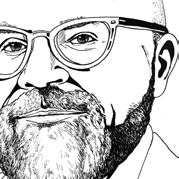 James Olstein illustrator / jamesolstein.com
James Olstein illustrator / jamesolstein.com

URBAN

08 4
ISSUE NUMBER
HEALTH REPORT FEATURE STORY
01 FOREWORD IN PHOTOGRAPHS
06 DEAN’S MESSAGE
10 Urban Health Report
Partnering with the Big Cities Health Coalition, Dornsife program expansions, heat and mortality in cities, urban health in Latin America, cancer health disparities in Philadelphia
All Hands on Deck
Through service, outreach, research, and advocacy, Dornsife faculty, staff, and students are taking unprecedented action amid the coronavirus pandemic.

Inequality in Latin America, new health and human rights journal partnership, working with global agencies
Restrictions on public housing after incarceration, public trust in government, tracking place-based policies in distressed communities
32
Educating parents about HPV through the power of social media
34
Reversing opioid overdoses at the community level, reducing food insecurity by empowering parents, strengthening an overwhelmed EMS safety net
30
Q&A
Can taking vitamin D help prevent my child from developing autism?
09 20 20 VOL/
Social Leveraging
Gender Identification
HIV in Africa
COVER STORY FEATURED
CONTENTS
Transgender adults holding gender-affirming IDs have better mental health 36
Pathways to reducing HIV risk in Africa
DEPARTMENTS
Global
16 FOCUS
Policy
Community
DORNSIFE Highlights
20 FOCUS
26 FOCUS
48
38
ILLUSTRATION BY JON KRAUSE
Urban Health Report
New partnership for more equitable cities
Dornsife Program
Expansions
Heat and Mortality in Cities
Urban Health in Latin America
In Philadelphia: Cancer Health Disparities
Big Partnership
Partnering with the Big Cities Health Coalition

20 20 VOL/ 10
IN THIS EDITION
To learn more about the estimated hospitalizations avoided and lives saved by stay-at-home orders visit bigcitieshealth.org/stayhomeimpact
PROGRAM
IN OCTOBER 2019 , the Dornsife School of Public Health, through its Urban Health Collaborative (UHC), joined in a new partnership with the Big Cities Health Coalition (BCHC) to support the Coalition’s vision of healthy, more equitable cities through big city innovation and leadership.
A powerful voice for public health departments in the nation’s largest, most urban cities, this new partnership with UHC is advancing BCHC’s work by bringing faculty, expertise, and resources in policy, planning, and evaluation, as well as data knowledge and infrastructure. Most importantly, the partnership is enhancing and supporting BCHC’s strong commitment to evidence-based urban health practice.
For the UHC, the partnership is an opportunity to advance its commitment to urban health locally and globally, leveraging the School’s historic expertise in public health practice in urban settings.
“This partnership is at the core of the UHC’s mission and commitment to research, training, and policy translation in urban health locally and globally,” said Jennifer Kolker, MPH, clinical professor in the department of Health Management and Policy, associate dean for public health practice and external relations, and co-lead of the UHC’s Policy and Community Engagement Core. “Through this partnership, BCHC and UHC will enhance their ability to meet their shared vision of improving the health of people living in our nation’s largest cities.”
Shortly after this partnership began, cities around the world were faced with the COVID-19 pandemic. Stay-at-home orders were issued for almost all large
cities, and residents began to face the loss of not only life, but livelihoods as well. Despite the many challenges of implementing stayat-home orders, they proved to be extremely crucial in slowing the spread of COVID-19.
With the BCHC, estimates were released in March that showed that early actions by its members, leaders from America’s largest metropolitan health departments, to get the public to stay home led to an estimated 2.1 million hospitalizations avoided and more than 200,000 lives saved.
These projections were covered widely by the media nationally at a time when stay-athome order fatigue was felt by the public. “Some communities struggle with seeing the value of staying at home. And it is a privilege to be able to stay at home and not work, or work remotely,” said Amy Carroll-Scott, PhD, MPH, assistant professor in the department of Community Health and Prevention at Dornsife and the UHC. “Messaging is important.”
These estimates, based on 45-day stay-athome orders, were calculated by the UHC using a model published by The New York Times.
Another way that the UHC is harnessing the power of data is by creating a platform that tracks COVID-19 outcomes and inequalities across major cities. Funding from the Robert Wood Johnson Foundation has enabled the development of this data platform that will provide timely comparisons of key COVID-19 indicators, as well as indicators of inequities in health outcomes, across BCHC cities over time.
While similar platforms exist at the state and county level, this platform will be the first city-level platform which enables city health officials, policymakers, and other partners to analyze data within and across large cities in the United States.
By 2050, more than 65 percent of the world’s population will live in cities. This shift in demographics means that cities present complex, large-scale health challenges, but also offer one-of-a-kind opportunities to translate public health solutions to communities of all sizes.
In order to adapt to public health professionals’ specific needs, the Dornsife School of Public Health has introduced a new online degree and online certificate focused specifically on urban health — the Master of Urban Health (MPH) and Graduate Certificate in Urban Health.
Addressing the health challenges created by urban living but also capitalizing on the health-promoting features of cities is critical to promoting population health worldwide.
“Even in the time of COVID-19 cities provide many opportunities to promote both health and environmental sustainability. Today more than ever we need to figure out ways to design, manage and govern cities so that they promote health and health equity,” said Ana V. Diez Roux, MD, PhD, MPH, dean and distinguished university professor of epidemiology at Dornsife.
Students in the new online Master of Urban Health (MPH) will train in the foundational principles of urban health practice. Rooted in the concept of health as a human right, this MPH teaches students to develop programs, policies, and solutions to contemporary urban health challenges that leverage policy and interventions on built physical and social environments to promote health and health equity.
To read more about the UHC’s COVID-19 initiatives, see “All Hands on Deck” on page 38.
The Graduate Certificate in Urban Health provides an introduction to urban health practice techniques, which help students build foundational knowledge in the field. The courses are built to benefit professionals in areas like community health, health education, and urban and regional planning.

11
ILLUSTRATION BY JAMES OLSTEIN
…
“Through this partnership, BCHC and UHC will enhance their ability to meet their shared vision of improving the health of people living in our nation’s largest cities.”
New Programs at Dornsife Bachelor of Arts in Global Health Online MPH in Epidemiology Online MPH in Global Health Online MPH in Urban Health Online Master of Science in Global Health Online Graduate Certificate in Infectious Disease Prevention and Control Online Graduate Certificate in Urban Health
Urban Health Training Continues to Expand at Dornsife EXPANSIONS
PROGRAM EXPANSIONS
The Fifth Annual Urban Health Summer Institute Goes Virtual

For the first time, the Urban Health Summer Institute hosted by the Dornsife School of Public Health’s Urban Health Collaborative (UHC) was fully online. Midway through the planning process, the UHC met the challenge to rethink how the event could continue during the pandemic. Despite the different format, more than 100 attendees from across the country gathered online to engage in trainings.
Attendees included faculty, students, and staff from universities such as NC State, Colorado State University, University of Pittsburgh, University of Puerto Rico, and many others. Participants included professionals from organizations across Philadelphia and the U.S., such as the Philadelphia Department of Public Health, Pew Charitable Trusts, Detroit Health Department, U.S. Department of Housing and Urban Development, Fox Chase Cancer Center, New Jersey Department of Health, and the Children’s Hospital of Philadelphia.
This year, the event included seven different courses from June 22-26, 2020. From introduction courses in urban health research to pivoting to the challenges of the pandemic, a range of courses offered attendees the opportunity to gain skills in tools, evaluation, and data analysis methods for public and urban health research.
In the exit survey and social media posts, participants remarked on just how much they learned from these condensed courses. Participants appreciated that it was offered online and that the content from the courses was very useful for their daily work. They thought that the courses were helpful and that the instructors were knowledgeable and engaging. Participants remarked upon how they will use the skills that they learned in their research and on the job to improve their programs and bring new perspective to their work.
Since the inception of the Urban Health Summer Institute in 2016, the UHC has trained more than
325 participants through this program.
12
Urban Health Report
IN MAY 2020 , the Pan American Health Organization (PAHO) and the Dornsife School of Public Health established a formal agreement to collaborate on efforts to promote urban health throughout Latin America.

The agreement facilitates ongoing collaboration between the Salud Urbana en América Latina (“Urban Health in Latin America”) or SALURBAL project, led by the Urban Health Collaborative at Dornsife, and the Health Promotion and Social Determinants Unit at the Regional office of PAHO/WHO in Washington, D.C.
With the joint goal of promoting urban health, the two groups will continue efforts to coordinate research and policy priorities, leverage regional contacts and engagement opportunities throughout policy processes, and identify ways to improve the capacities of the local governments throughout the region.
The teams have worked together on multiple initiatives in recent years. PAHO representatives have played a key role in providing feedback and insights about the SALURBAL research project and relevance for local actors throughout the region.
In October 2019, Ana V. Diez Roux, MD, PhD, MPH, dean and distinguished university professor of epidemiology at Dornsife, joined Gerry Eijkemans, chief of PAHO’s Health Promotion and Social Determinants Unit, and mayors from across the Americas at the third meeting of the Health Municipalities, Cities and Communities Movement. The meeting took place in Paipa, Colombia and marked the official launch of a policy brief on “Health in All Urban Policies,” which was co-produced by the SALURBAL and PAHO teams.
Promoting healthy and sustainable cities requires concrete guidance, experience, and collaboration across many sectors to address the determinants of urban health. In today’s context of uncertainty and global challenges, PAHO and Dornsife remain committed to the goals of supporting development to improve health, equity, and environmental sustainability. Now more than ever, urban inequalities need to be addressed to better respond to emergencies like the COVID-19 pandemic.
For updates on work regarding heat and mortality in urban areas, visit, bit.ly/UHCheat20.
Heat and Mortality in Cities

Each year, more than 600 people in the United States are killed by extreme heat, according to the Centers for Disease Control and Prevention (CDC). In addition to measures of public safety surrounding the coronavirus pandemic, temperatures in Philadelphia soared above 90 degrees on multiple days during July 2020, causing the city to declare several heat health emergencies with various relief and safety measures taken.
Lower socioeconomic and racial or ethnic minority groups are particularly vulnerable to both heat and coronavirus. Heat vulnerability is of particular concern in cities, due to the urban heat island effect, which is attributable to the large amounts of concrete and asphalt and lack of vegetation. Within cities, variation in built environment and land cover characteristics, such as vegetation and tree canopy, creates different microclimates. Such characteristics may also vary along sociodemographic lines.
These concurrent public health threats caused new challenges for the city. Because of coronavirus safety precautions, the usual areas for respite from the heat such as public pools or air-conditioned spaces like public libraries were not open. To keep residents of the city safe from the heat, public health officials had to execute new solutions like utilizing SEPTA buses with air-conditioning as cooling stations.
“We all feel and complain about the heat, but let’s also remember this is an important public health issue, and one that is most severe for those who are also most COVID-vulnerable,” said Leah Schinasi, PhD, assistant research professor at the Dornsife School of Public Health and the Urban Health Collaborative (UHC). Schinasi studies the impact of heat in cities and what it means for health.
From 2016-2019, Schinasi led a pilot study out of the UHC on the associations between temperature and infant mortality in Philadelphia.
Heat vulnerability is of particular concern in cities, due to the urban heat island effect, which is attributable to the large amounts of concrete and asphalt and lack of vegetation.
Physiologically, infants have less developed regulating body systems, high metabolic rates, higher heart rates than adults, and low whole-body sweating rates. Because of their newness to the world, there is little opportunity for their bodies to acclimate. The association between heat and infant mortality is understudied because infants are not always recognized as a heat-sensitive subpopulation.
In addition to the need for more research on infants’ susceptibility to heat, her team notes that the elderly and those with underlying medical conditions are among the most vulnerable to heat. As temperatures continue to rise globally, public health leaders must continue to fill this gap in knowledge on optimal ways to adapt to earth’s rising temperatures.
13 20 20 VOL/
36
Number of days of 90+ degree temperatures recorded in Philadelphia from Jun 1 through Aug 31, 2020.
The longterm average is 21 days.
Urban
Public Health: A Research Toolkit for Practice
and Impact edited by Diez Roux, Gina Lovasi, PhD, MPH, UHC co-director, and Jennifer Kolker, MPH, clinical professor in the department of Health Management and Policy, associate dean for public health practice and external relations, and co-lead of the UHC’s Policy and Community Engagement Core, tackles a wide range of urban health topics.
The overall progress of urban health is measured and monitored by the constant support and care of all people who live within urban landscapes, no matter someone’s social position or health status. This book articulates perspectives and baseline knowledge crucial to the field of urban health, and the research and partnership strategies which can guide cities toward better population health and health equity outcomes. Examples and expertise are shared throughout the book from contributors at the UHC and across its network of Philadelphia-based and global partner organizations.
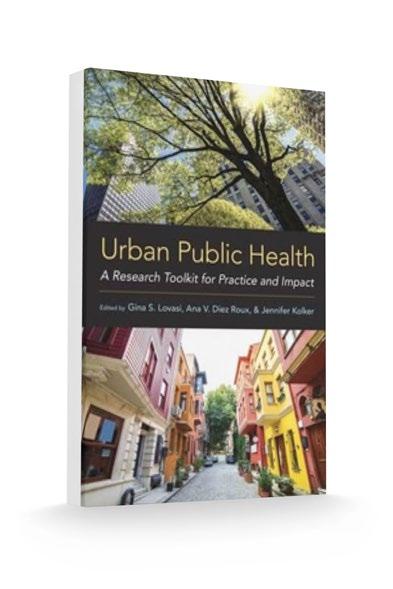
This book is tailored for building capacity for emerging professionals in public health, though there is also clear relevance to urban planning, social sciences, policy creation, and more.
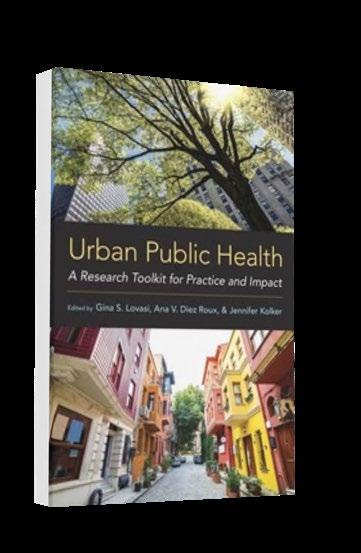
14 EXCERPT
URBAN PUBLIC HEALTH: A RESEARCH TOOLKIT FOR PRACTICE AND IMPACT
“An increasing majority of the human population resides in urban areas, and residents are affected in multiple ways by these settings. Our lives and our health are shaped by the design of buildings and transportation systems, access to improved sanitation and early childhood education, the availability of food stores and recreational spaces, and by a wide range of local policies from housing to health care access . Urban health can be conceptualized as an object, a goal, and an area of scholarship and practice.”
PROGRAM EXPANSIONS
New Dornsife Course Further Examines Health Inequities in Cities
At the start of 2020, Sharrelle Barber, ScD, MPH, assistant professor in the department of Epidemiology and Biostatistics at the Dornsife School of Public Health and the Urban Health Collaborative, led a newly designed course that examines the differences in life expectancy and other markers of morbidity and mortality that exist within small distances in urban areas across the United States and around the world. This course is now a core class in the online Masters in Urban Health (MPH) at Dornsife.
Students enrolled in the course will examine the root causes of differences in health like residential segregation, gentrification and displacement, and racialized violence. These issues will be studied through an explicit structural racism lens.
In addition to identifying these inequities, students will explore public health interventions and models for action to improve health.
Cancer Health Disparities in Philadelphia
A NEW REPORT RELEASED in September 2020 by the Urban Health Collaborative at the Dornsife School of Public Health, the Philadelphia Department of Public Health, and Fox Chase Cancer Center uses existing data on cancer rates in Philadelphia to give a thorough look at how cancer and its risk factors have changed over the past decade and how they vary by socioeconomic factors and race.
The comprehensive report, which is the first of its kind, outlines key analysis for public health agencies, policymakers, and healthcare providers to better serve people and make informed choices on resource allocation. Alongside the report, the researchers have also developed a community brief and an interactive dashboard. The dashboard is a comprehensive interactive site to explore information from the report on cancer incidence, screening, and mortality data in Philadelphia by race/ethnicity and sex for different cancer types.
Researchers used data from the 2000-2016 Pennsylvania Department of Health Cancer Registry and the Vital Statistics Registry from the Pennsylvania Department of Health’s Bureau of Health Statistics & Registries. For statistics on the cancer screening and risk factors, such as race and education level, the report draws from nine surveys conducted between 2000 and 2018 by the Southeastern Pennsylvania Household Health Survey from the Public Health Management Corporation.
While incidence and mortality rates for many cancers have been steadily decreasing over the past few years, the fight is far from over. Liver cancer incidence and mortality have increased in both men and women. Breast cancer incidence and lung cancer incidence have increased in Black women as well.
Similar to the health disparities seen in the coronavirus pandemic, racial and socioeconomic disparities persist. Cancer mortality is
CANCER DEATHS BY RACE/ETHNICITY AND INCOME IN PHILADELPHIA, 2016
higher for Blacks than for other races and ethnic groups and is also higher in neighborhoods with relatively lower levels of education.

People with lower education have significantly higher levels of cancer risk factors than those with higher education. Some cancer risk factors have improved in recent years, but rates of obesity, diabetes, and binge drinking have increased, and fruit and vegetable consumption remain low. Philadelphia residents, including Black men and women, reported high rates of screening for most common cancers.
Researchers call for programs and policies that reduce disparities by promoting healthy lifestyles — lowering rates of smoking and obesity and encouraging access to healthy fruits and vegetables and exercise — as well as initiatives that provide universal access to cancer screening and treatment.
This research was supported by the Lazarex Cancer Foundation as part of the Community IMPACT project. The goal of Community IMPACT, a collaboration between the Dornsife School of Public Health, Drexel College of Nursing and Health Professions and Lazarex is to improve understanding and awareness of the burden of cancer on patients.
15 20 20 VOL/
RACIAL DISPARITIES Cancer mortality is higher for Blacks than for other race and ethnic groups
Global

16
20 20 VOL/ FOCUS
Our Common Ground
What lessons can Philadelphia learn from inequality observed in Latin American cities?
influence the health of the 80 percent of Latin Americans who reside in cities.
IN LATE 2019, a Dornsife School of Public Health study found wide-ranging differences in lifespan in six major Latin American cities. The findings — which may be the first to give comprehensive, standardized data about life expectancy at birth within small areas of the cities — help researchers pinpoint what forces are linked to these disparities and what lessons can be learned by Philadelphia and other cities experiencing similar issues.
The findings, published in The Lancet Planetary Health from researchers at the Salud Urbana en América Latina (SALURBAL), or Urban Health in Latin America project at Drexel University’s Dornsife School of Public Health, are the latest among growing efforts by the group to evaluate how environment and public policies
The team looked at six Latin American cities that are collectively home to more than 60 million people – Buenos Aires, Argentina; Belo Horizonte, Brazil; Santiago, Chile; San Jose, Costa Rica; Mexico City, Mexico; and Panama City in Panama – and found broad contrasts in life expectancy when comparing specific areas located within these six metropolitan locations.

The researchers mined each country’s census and vital registration data for stats on socioeconomic status measures, death rates, gender and other population metrics, and did the heavy lifting of standardizing the data for all areas that make up these cities. The researchers then calculated life expectancy at birth by gender for each of the areas in the six locations.
The group found higher differences in life expectancy at birth within cities than among cities. For example, the largest difference was found within Panama City, where residents of the areas with the highest life expectancy live 18 years longer, on average, than residents of areas with the lowest life expectancy. Meanwhile the difference between the city with the highest overall life expectancy (Panama City) and the lowest life expectancy (Mexico City) was much lower — seven years for men and 11 for women.
17
Greg Richter Writing
By comprehensively studying life expectancy in these areas, the researchers uncovered some of the earliest data used in pinpointing the determinants, or factors, that influence health for residents.
“These stark differences in health across neighborhoods arise from differences in social circumstances and physical environments that can be addressed through policy,” said SALURBAL principal investigator Ana V. Diez Roux, MD, PhD, dean and distinguished university professor of epidemiology at Dornsife. “They highlight how health is affected by much more than health care.”
Action to fix disproportionate wealth and improve population health cannot begin without data. In a strategic plan published in October 2019, the Pan American Health Organization acknowledged that equity is “at the heart of health,” but progress is limited by a “lack of consistent disaggregated data to track and reveal disparities.”
Similar data from the U.S. Centers for Disease Control and Prevention and the Associated Press reveal even broader disparities in life expectancy in Greater Philadelphia. Residents in nearby Lower Merion Township in Montgomery County have an average life expectancy of 92 years, while life expectancy a few miles away in Philadelphia’s Strawberry Mansion section is at 64 years.
Where you live can have a major impact on your lifespan, both in Philadelphia and its suburbs. This can also be said for much of Latin America.
Continued Legacy
New Health and Human Rights Journal Partnership
To the world, Jonathan Mann, MD, MPH, was the first head of HIV programs at the World Health Organization and an international champion of human rights. To the grateful faculty, staff, and students of the Dornsife School of Public Health, he is also fondly remembered as the founding dean.
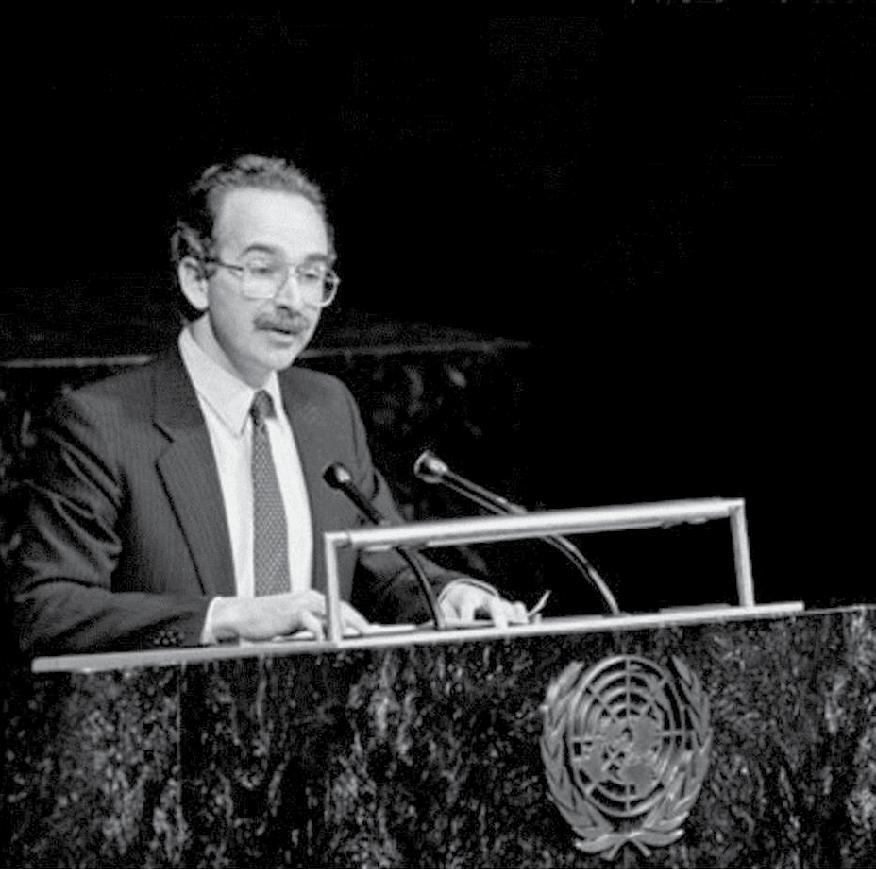
A visionary scholar, advocate, and scientist, the hallmark of Mann’s career was the degree to which he highlighted and advanced knowledge about the critical link between public health and human rights in the United States and around the world.
On Human Right’s Day, December 10, 2019, Dornsife
announced yet another result of Mann’s valuable legacy – a new relationship with the Health and Human Rights Journal (HHR), a publication of the François-Xavier Bagnoud (FXB) Center for Health and Human Rights (where Mann was the first director) at the Harvard T.H. Chan School of Public Health and Dornsife.
“For the twenty-fifth year of the publication of the Health and Human Rights Journal, it is fitting that the FXB Center and Dornsife are announcing this partnership,” said Joe Amon, PhD, MSPH, clinical professor and director of the Office of Global Health at Dornsife. “The Health and Human Rights Journal, from its start, helped to advance scholarship on the right to health and to examine how health rights can be operationalized and how they can promote accountability. I’m looking forward to a close partnership with the FXB Center and the opportunity to be a part of the next phase of the Journal’s history.”
This partnership not only celebrates the shared history of the two schools, but is also an opportunity for both institutions to communicate, through the journal, and to have important discussions about health and human rights, while furthering Mann’s original mission for the journal.
18
Global FOCUS
Jonathan Mann speaks at the United Nations General Assembly in 1987.
To learn more visit hhrjournal.org.
PHOTO COURTESY UN/DPI PHOTO BY SAW LWIN
Global Impact in Practice
Working with Global Agencies
THE DORNSIFE SCHOOL of Public Health is dedicated to strengthening public health systems and the public health workforce not only locally, but also globally. Through its Office of Global Health, Dornsife works closely with ministries of health, NGOs, academic institutions and low- and middle-income country partners to develop mutually beneficial capacity building, training, and research collaborations in regions such as Asia, Africa, Europe, Latin America, and the Caribbean Islands.
Strengthening partnerships with health and human rights organizations throughout the world enables the School to maximize impact. Below are a few key partnerships:
The Global Fund
In 2017, the Global Fund against HIV/ AIDS, tuberculosis (TB), and malaria launched an initiative called Breaking Down Barriers (BDB), with the aim of strengthening communities and scaling up programs to remove human rights-related barriers to HIV, TB, and malaria services and expand access, uptake, and retention in prevention and treatment services in 20 countries.
The initiative funds programs that address stigma and discrimination, train health care providers on human rights and medical ethics, sensitize lawmakers and law enforcement agents, reduce discrimination against women, promote legal literacy, expand access to legal services, and monitor and reform laws, regulations, and policies.
The Dornsife School of Public Health, with the leadership of Joe Amon, PhD, MSPH, clinical professor and director of the Office of Global Health, and Nina Sun, JD, assistant clinical professor, both in the department of Community Health and Prevention at Dornsife, is leading the mid-term assessment of the project, evaluating accomplishments to date and the achievement of comprehensive national human rights programming.
The United Nations International Children’s Emergency Fund
In March 2020, a new framework that measures, tracks, and evaluates changes in social norms related to female genital mutilation (FGM), known as the ACT Framework, was implemented in Guinea and Ethiopia.
Researchers from the Dornsife School
Number of countries in which Dornsife currently has partnerships through its Office of Global Health
of Public Health, including Suruchi Sood, PhD, associate professor of Community Health and Prevention, developed this framework in partnership with the United Nations Fund for Population Activities (UNFPA) and the United Nations International Children’s Emergency Fund (UNICEF), in consultation with experts around the world.
According to UNICEF, an estimated 3 million girls in various parts of Africa, the Middle East, and Asia continue to be subjected to FGM and 200 million girls and women worldwide have been affected by FGM. The tools and methods provided in the framework can be adapted to local contexts. Once the data from Guinea and Ethiopia is validated and additional expert consultation takes place, researchers hope to share the ACT Framework globally.
The
Joint United
Nations Programme on HIV/AIDS
The emergence of COVID-19 was marked by widespread use of criminal law as well as more broadly punitive approaches that restricted rights. Some of these
measures were opportunistic, some restricted freedom of speech and expression, including whistleblowers, and some—while seeking to enforce social distancing, curfew or quarantine orders— may have increased risk of transmission and disproportionately impacted vulnerable populations and marginalized communities. Recognizing that there is no global consensus on the use of criminal law or other punitive measures in public health emergencies (despite decades of attention to criminal law in the HIV response), this project, funded by The Joint United Nations Programme on HIV/AIDS (UNAIDS) and led by Amon and Sun, will summarize scholarship on criminal law and HIV and track examples of how criminal sanctions and other punitive measures are being used to enforce public health measures in response to COVID-19. Dornsife will work with UNAIDS to prepare a document outlining key principles on public health, human rights, and criminal law during public health emergencies.
The United Nations Development Program
As countries work towards universal health coverage, they are transforming their health systems to take advantage of digital tools, approaches, and big data. The use of digital technologies in HIV-related programs provides opportunities for improved access to quality health services at lower costs but also raises new issues related to human rights, especially the rights to information and privacy. Achievement of health equity in the use of digital technologies is also a key consideration, particularly as digital approaches vary across contexts.
The United Nations Development Program (UNDP) contracted Dornsife to support the development of practical guidance to countries on how to incorporate attention to human rights and equity in the development of their national digital health strategy.
Amon and Sun worked closely with UNDP to prepare the guidance and solicit input from across the United Nations, government officials, academia, and civil society to discuss the critical areas of governance and support to countries on the policies and regulations needed to guide effective scale up and equitable application of digital technologies in HIVrelated interventions.
19 20 20 VOL/
28
Policy
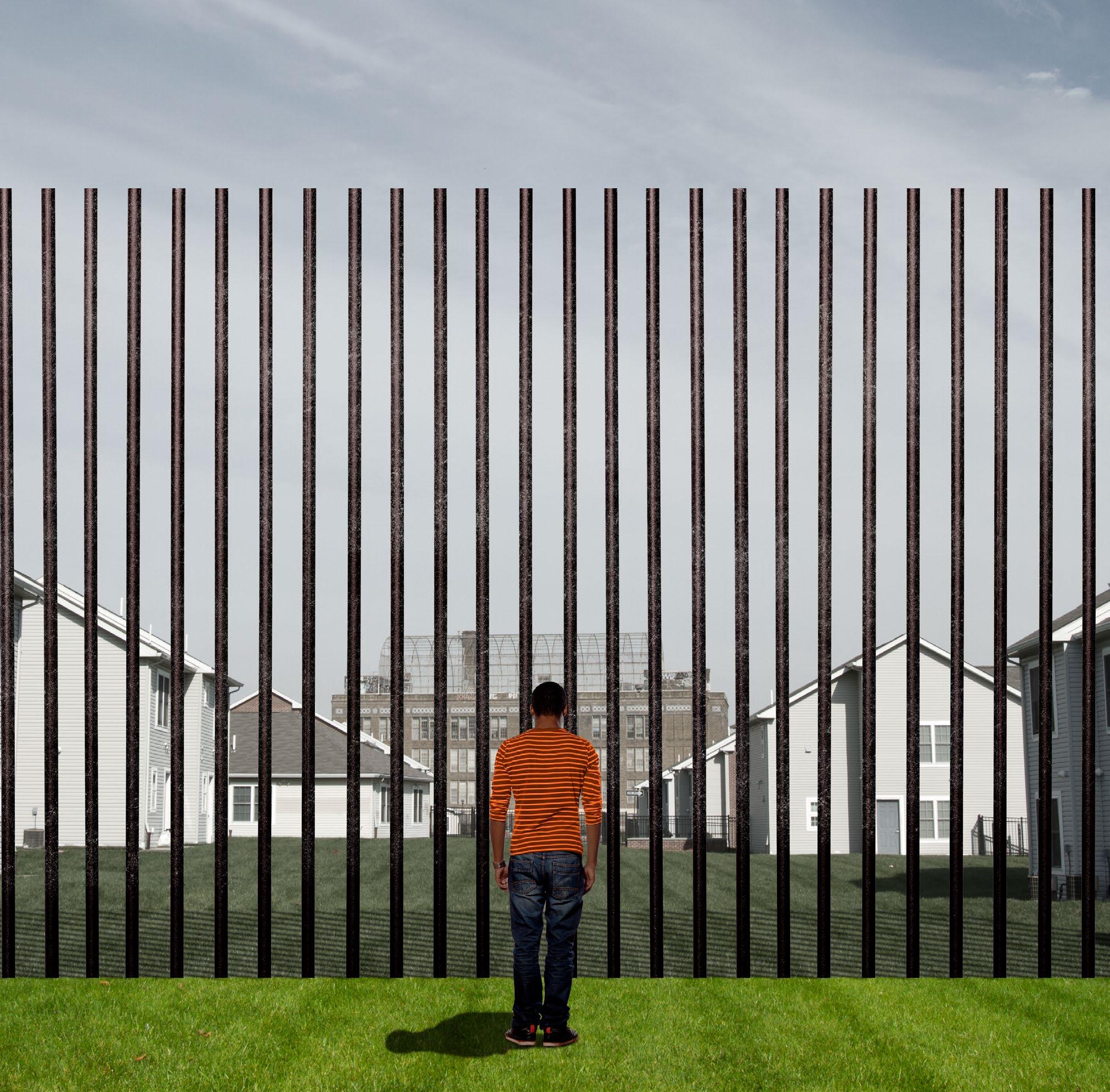
20
20 20 VOL/ FOCUS
After Incarceration

Restrictive public housing policies generate health inequity
to trace these connections. An an associate professor of health management and policy at the Dornsife School of Public Health—and an alumnus who earned both of his graduate degrees there—Purtle’s expertise centers on the dissemination and implementation of policies that influence mental health and health equity.
GOVERNMENT-FUNDED rental assistance represents one of the few sources of affordable housing available to low-income families and individuals in the United States. But many local authorities have restricted individuals with criminal justice histories from public housing. Because Black people are significantly more likely to have been incarcerated, they are therefore also more likely to be excluded from subsidized housing. And because stable housing has well-established health benefits, restrictive policies can drive inequitable health outcomes.
Jonathan Purtle, DrPH, MPH, MSc, was lead author of an article recently published in the American Journal of Public Health that starts
Recognizing his skill at analyzing policy documents, Kim Blankenship, PhD, a colleague at American University, asked him to get involved in a slice of a major study funded by the National Institute of Mental Health. The larger study, “The Justice, Housing and Health Study,” represents a collaboration between Dornsife, American University, and Yale School of Public Health and examines how mass incarceration and housing vulnerabilities intersect to create health risk, with a focus on HIV. Although Purtle had not previously conducted much research on housing or criminal justice, he seized the opportunity to do both.
“There is an emerging field of legal epidemiology that looks at the association between different laws and health outcomes,” he explained. “Part of that is doing a content analysis on legal text or policies.” For the smaller study, his team measured policy variations across local public housing authorities related to involvement with the criminal justice system.
21
Karyn L. Feiden Writing
Innovative Study Design
A unique aspect of the study was its use of a methodology known as factor analysis, which allowed the researchers to create a restrictiveness score based on a composite of policy provisions.
In a more traditional design, a city’s public housing policies would have been tracked with simple “yes/no” responses — does this city have that restriction, does it have this one? But that approach would not uncover the insights that emerged by aggregating multiple factors, said co-author Luwam Gebrekristos, who earned her MPH at Dornsife in 2016 and enters the school’s PhD program in biostatistics in the fall of 2020. As she explains, “It is not a single policy within the local housing authority that intersects with the criminal justice system. Creating a single variable that encompasses all those policies tells us more.”
The scale used in this research was based on a cluster of eight provisions that were key in determining whether an individual with a criminal justice history could be admitted into public housing and permitted to remain there. Among the policies included in the restrictiveness measure were those that explicitly considered mitigating circumstances, family impact, and proof of good tenancy.
The ultimate goal was to elucidate the line from criminal justice involvement to stable housing to health outcomes, Purtle said. “You can do that with more sensitivity and precision if you have a continuous variable that captures what you are interested in along a continuum, as opposed to a dichotomous variable that is just ‘yes’ or ‘no.’”
Variation in Restrictions
Although the analysis uncovered substantial variations, local housing policies were generally more restrictive than federal law requires. Significantly, most authorities retain substantial discretion to decide who gets housing and who does not on the basis of their criminal justice history.
“That creates a lot of room for bias to enter an equation,” said Purtle, stepping back to reflect on the larger aims of the study. “Let’s say our goal is to write the least restrictive policy. That does not look like giving policy implementers a lot of leeway, it looks like being very clear and concrete in terms of whether, or under what conditions, criminal justice restrictions are imposed.”

And why would few or no restrictions be a goal? “That is where research and advocacy and values come in,” said Purtle. “All of us on the research team feel that no restrictions would be best. That is our personal ideological perspective, but also moving away from our own perspective, the research evidence shows that housing is an extremely important social determinant of health. If you want to remove health inequities, you want to remove policies that have disparate impact on communities of color.”
“Given that stable housing is a critical social determinant of health and given the disproportionate representation of Blacks in the criminal justice system, these polices could contribute to health inequities.” (Purtle et al., American Journal of Public Health, 2020)
Committed to moving evidence into action, the researchers continue to examine the health implications of restrictive public housing policies. Applying the methodological tools that proved so incisive in this study, they will look next at whether restrictiveness is associated with a higher incidence of HIV and sexually transmitted diseases. The hypothesis, said Purtle, is that restrictive policies will prove to be a pathway to health inequity.
22
Policy
FOCUS
“Given that stable housing is a critical social determinant of health and given the disproportionate representation of Blacks in the criminal justice system, these polices could contribute to health inequities.”
PORTRAITS BY NATALIE HOPE MCDONALD
JONATHAN PURTLE, D r PH, MPH, MS c Associate professor, Dornsife School of Public Health
“Individuals face numerous barriers to reintegration after incarceration, and housing poses a particular challenge. Upon leaving prison, they simultaneously face financial challenges— 45 percent of re-entrants do not earn any income in the first year after incarceration —and a severe affordable housing crisis. Across the United States, fair market rents have increased faster than wages such that there is currently no state where full-time minimum-wage work is sufficient to rent an unsubsidized fair-market 2-bedroom unit .
Government rental assistance programs are one of the few sources of affordable housing available to low-income renters, particularly for Blacks—who are the head of household (i.e., leaseholder) of approximately 44 percent of the public housing units in the United States. Recent research suggests positive effects of rental assistance on psychological well-being, overall self-rated health, and access to health care . However, public policies impose restrictions on the ability of people with criminal justice histories to access rental housing assistance and achieve housing security.”
23 20 20 VOL/
PURTLE ET AL., AMERICAN JOURNAL OF PUBLIC HEALTH, 2020
EXCERPT
Health officials testify during a House Oversight Committee Hearing on Coronavirus preparedness and response on Capitol Hill in Washington, DC. A recent study showed that members of both political parties supported greater use of ‘evidence’ — information based on reliable data and produced by statistical methods — in development of health policy.

Unhealthy Outlook
Americans’ trust in their government is low. Is that fair?
No matter who is in elected office, citizens may agree or disagree with specific policies, positions, action or inaction, but public trust in our elected representatives is at a mere 17 percent, according to a Pew Research Center report released in 2019. So, what accounts for this low level of trust? What do citizens want, and could using scientific evidence to pass bills in citizens’ interest help restore that trust?
Takeaways from three papers by Jonathan Purtle, DrPH, MPH, MSc, an assistant professor in the Dornsife School of Public Health, and colleagues, offer some insights.
1. The public wants legislators to use more ‘evidence’ in making health policy.
A brief report Purtle published in June 2019 in Translational Behavioral Medicine exposed a wide gap between what Americans say they want out of lawmakers and what they perceive they’re getting.
In a 2018 public opinion survey, 532 Americans were asked to what extent six factors “should have” and “currently have” influence on health policy decisions made by members of the United States Congress, including industry interests, evidence and budget costs. The result? Despite political division between Democrats and Republicans, members of both parties supported greater use of ‘evidence’ – information based on reliable data and produced by statistical methods – in development of health policy. Although 59 percent of respondents said that evidence should have “a lot of influence” on policy, only 11 percent said that evidence currently has “a lot of influence” on those decisions.
Purtle noted in the paper that U.S. Congress members might be held more accountable by encouraging efforts to disclose evidence behind policy decisions.
24
Writing
Greg Richter
Policy FOCUS
2. Legislators’ opinions about the effects of childhood trauma vary along party lines.
In a study published in July 2019 in the journal Psychiatric Services, Purtle and colleagues surveyed state legislators about adverse childhood experiences, such as physical or mental abuse, and how experiencing this trauma can influence behavioral health problems as an adult.
Despite clear evidence from the 1998 Adverse Childhood Experiences Study and subsequent research demonstrating that abuse, neglect, and witnessing violence during childhood all increase risk for behavioral health problems as an adult, just over half of those identifying as liberals and less than a third of their conservative colleagues said that witnessing domestic violence can be a risk factor. Additionally, men were far less informed than their female colleagues: female legislators were significantly more accurate at identifying these types of childhood experiences as risk factors than their male counterparts were.
3. Sometimes legislators get it right.
Vaccine-preventable disease (VPD) outbreaks are increasing in frequency in the United States, but legislation aimed at increasing childhood vaccination rates is also rising in places where those epidemics occurred, according to findings published in November 2019 in JAMA Pediatrics from Neal Goldstein, PhD, an assistant professor in Epidemiology & Biostatistics in the School of Public Health, Purtle, and colleagues.
Sometimes politicians get it right and sometimes they simply fall short. The more we understand about the motivations behind policies, the more trust can be restored in our elected officials.
Health and Home
Tracking Place-Based Policies in Distressed Communities
IN JANUARY 2020 , Jana A. Hirsch, PhD, MES, assistant research professor in the department of Epidemiology and Biostatistics at the Dornsife School of Public Health, along with the Dornsife Urban Health Collaborative team, released a report on living conditions in federally qualified opportunity zones (QOZs) and how they may impact health.

prevalence of all unhealthy behaviors, except binge drinking, was higher in QOZs. The paper also provided results by state and within an interactive app to facilitate evaluation of QOZ by local stakeholders.
Evaluating the effects of QOZs on health is critical. Previous research linking place-based policies like QOZ to health is limited, and QOZs will most benefit distressed communities if investors, local governments, and community organizations have the data they need to guide investment and shape how this policy is implemented. Public health can and should be part of that discussion.
Hirsch’s study, “Health and HealthRelated Resources in Newly Designated Federally Qualified Opportunity
Zones: United States, 2012–2016,” was published in the American Journal of Public Health.
The federal government implemented QOZs through the Tax Cuts and Jobs Act of 2017. This legislation was intended to incentivize private investment in distressed communities through tax breaks, with the hope that they will have a positive and dramatic effect on American neighborhoods and the health of residents who live within them.
Neighborhoods with a QOZ designation have the potential to see economic development that changes the retail and physical environment. New neighborhood resources could promote healthy behaviors, such as increased physical activity and enhanced diet quality, to ultimately improve cardiovascular and other chronic health outcomes.
However, QOZs could also have less beneficial or unequal effects through changes in population, shifts in social engagement among neighbors, gentrification, and displacement of vulnerable populations.
Compared to non-QOZ communities, on average QOZs had fewer people, a younger population, and lower proportions of non-Hispanic White residents. QOZ tracts had lower economic status and substantially lower density of physical activity resources. QOZs also had a higher density of walkable destinations for daily living, food stores, social destinations, and social services than tracts that were eligible for the program but were not designated. In addition,
There are a few key strategies public health officials could engage in to maximize health benefits in QOZs. Enacting policies that would increase affordable housing in these zones could have the potential to reduce displacement and its subsequent health impacts. Public health practitioners should also collaborate with local urban planning departments to implement zoning that could encourage health-promoting businesses in QOZs. Similarly, larger benefits may emerge by pairing public and private investments that impact health, including new or improved parks or pedestrian infrastructure. Public health may play a key role in ensuring that future evaluations assess impacts on health disparities. Finally, QOZ designation may offer public health officials an opportunity to engage locally and mobilize residents around neighborhoods’ impacts on health.
In collaboration with other experts aiming to understand the social, economic, or business outcomes of this federal legislation, public health has a key role to play. “We must work to ensure that the health impacts of this place-based policy are not just tracked across time but also used to advance health equity across communities,” said Hirsch. —Sarah Greer
25 20 20 VOL/
JANA A. HIRSCH, PHD, MES assistant research professor in the department of Epidemiology and Biostatistics
Community
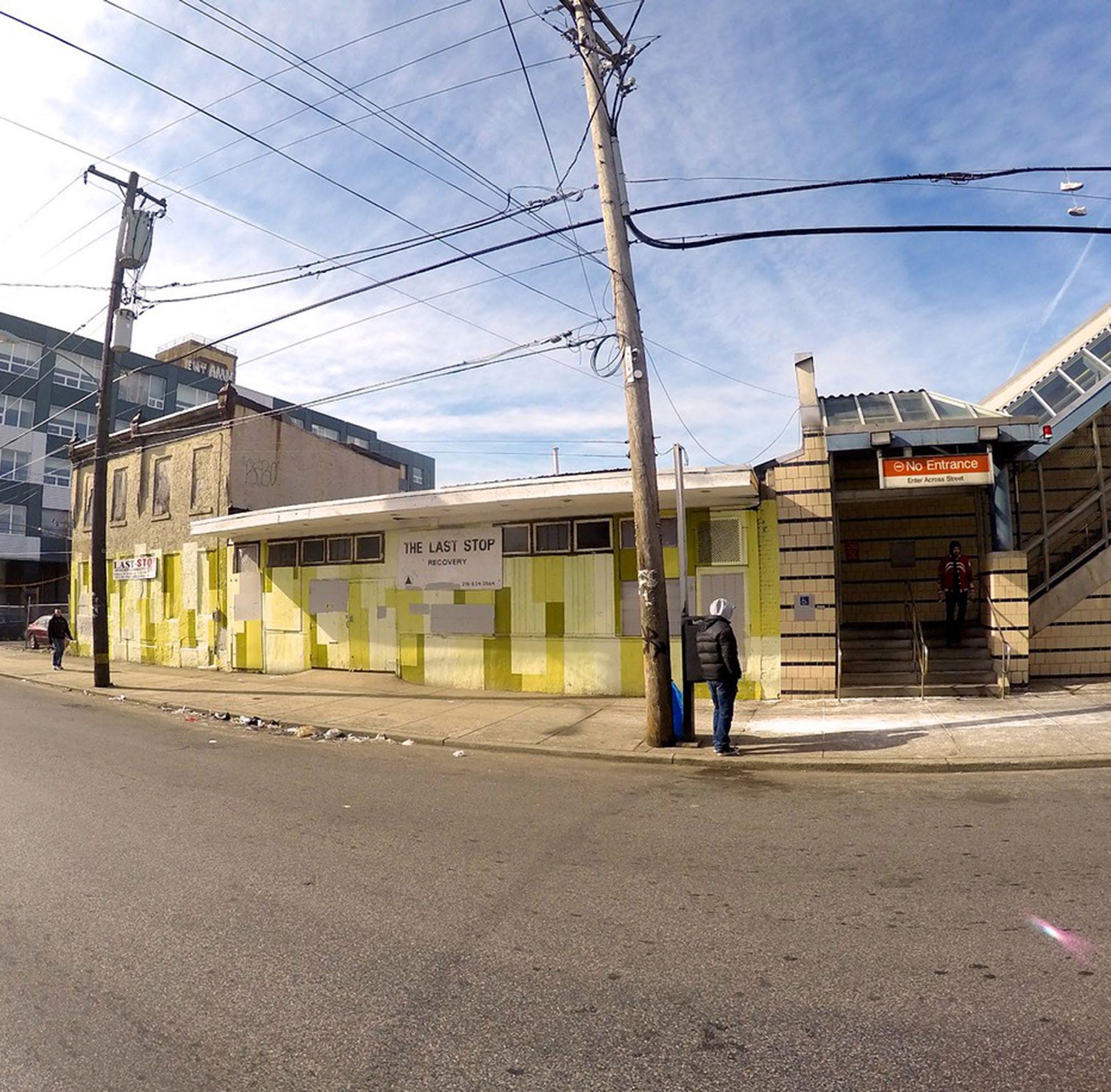
26
20 20 VOL/ FOCUS
Greg Richter Writing
Rapid Response
Reversing opioid overdoses at the community level
additional 52 overdose emergencies, the participants who witnessed the overdose signaled an alert with the app and then administered Naloxone themselves. A successful reversal was reported in 95.9 percent (71/74) of cases. In over half of these events (59.5 percent), study participants administered Naloxone more than five minutes faster than Emergency Medical Services (EMS) were able to arrive on scene.
EQUIPPED WITH NALOXONE and a smartphone app, community members can save lives in the fight against America’s opioid crisis, according to a paper from researchers at the Dornsife School of Public Health and colleagues published in August 2020 in The Lancet journal EClinicalMedicine
During a pilot study, researchers found that enrolled participants were able to signal and respond to opioid overdoses using a smartphone app, called UnityPhilly, developed by the Dornsife team. During 22 overdose emergencies, a participant received an overdose alert on the UnityPhilly app, traveled to the location and then administered Naloxone to the overdose victim at the scene. In an

During the yearlong observational study that concluded in February 2020, 112 adult Philadelphians, 57 of whom use opioids reported 291 suspected overdoses and alerted nearby volunteers using the UnityPhilly app.
All study participants were trained in how to administer Naloxone, use the app and give rescue breathing, and were then provided with two doses of Naloxone. Every time an alert was signaled by pressing an “SOS” button in the app, it also alerted EMS via 911, which allowed them to follow up with their protocol, regardless of whether a layperson responded.
“We know that the lay public is effective at administering Naloxone, but now we know that an app can help laypersons provide Naloxone faster when every second counts,” said senior author Stephen Lankenau, PhD, a professor and associate dean for research at the Dornsife School of Public Health, who co-led the study with David Schwartz of Bar-≠Ilan University,
27
STEPHEN LANKENAU, P h D Professor and Associate Dean, Dornsife School of Public Health

Israel. “By empowering community members with these tools, we strengthen the ‘chain of survival,’ and keep people alive until EMS or other medical personal administer further aid.”
Unless it is reversed in time, an overdose from opioids, such as heroin, or pain relievers, like Oxycodone or Fentanyl, can cause breathing to slow or stop. Naloxone works as an antagonist that connects to opioid receptors to prevent the effects of other opioids in the body. Signs of an overdose include skin feeling cold, blue nails and lips, slow heartbeat and vomiting, among other symptoms.
In 2018, U.S. overdose deaths decreased for the first time in 25 years with 67,367 drug deaths, roughly seven out of 10 involving opioids. However, that rate rose nearly 5 percent to an estimated 72,000 in 2019, according to the Centers for Disease Control and Prevention. The coronavirus pandemic is also suspected of raising overdose deaths and other “deaths of despair.” As of July 15, drug deaths are up 13 percent this year compared to last year, according to government data compiled by The New York Times Philadelphia has the highest per capita overdose mortality rate among large U.S. cities, with 1,150 deaths in 2019, a number up 3 percent from 2018.
A Nourishing Support Network
Reducing food insecurity by empowering parents
As the coronavirus pandemic forces so many to reckon with growing food insecurity and increased health challenges, the Building Wealth and Health Network program of the Dornsife School of Public Health’s Center for HungerFree Communities is reducing food insecurity and improving mental health – without distributing any food or medicine. How? The Network is focusing on group experiences that promote healing and help people save money and take control over their own finances.
Parents of young children, who completed the Center’s 16-session, trauma-informed program, are 55 percent less likely to experience household food insecurity than those who did not complete the program, known as “The Network.” The study included 372 Philadelphia parents of children under six years old enrolled in the four-to-eight-week-long program.
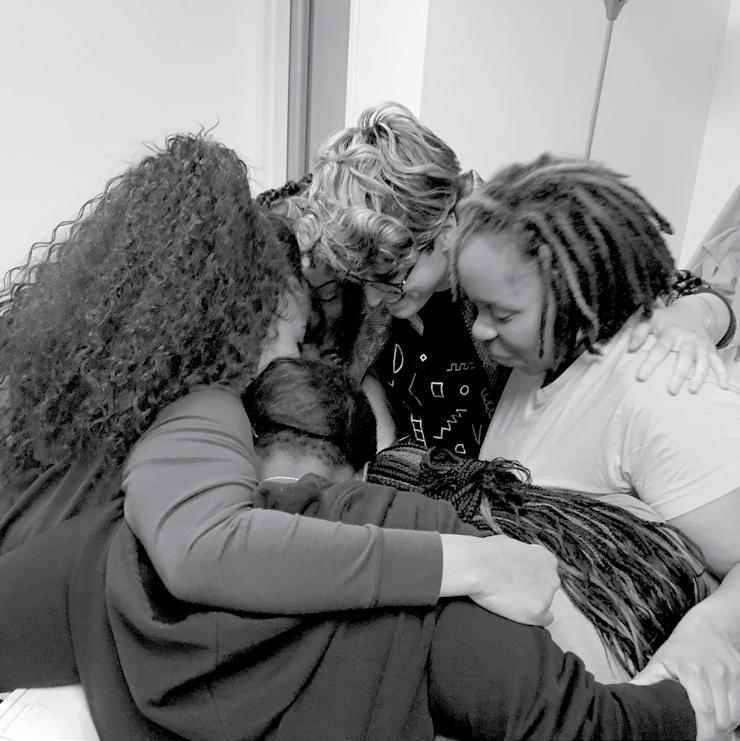
Parents of young children, who completed the Center’s 16-session, traumainformed program, are
Percentage of cases
the
The study focused on four Philadelphia zip codes, with participants recruited in the Kensington neighborhood, which experiences higher drug use and availability of Naloxone than other areas of the city. The authors will next look at a citywide study to test if the app can be scaled for all of Philadelphia.
In addition to the program, all participants were either receiving cash assistance through Temporary Assistance for Needy Families (TANF), and/or support from the Supplemental Nutrition Assistance Program (SNAP), formerly known as food stamps. The findings were published in the Journal of Nutrition Education and Behavior.
According to an April Brookings report, one in five United States households is currently
55 % less likely to experience household food insecurity than those who did not complete the program
28
Community FOCUS
96 %
during
study in which a successful opioid reversal was reported when using the UnityPhilly app
Greg Richter Writing
experiencing food insecurity, with that number expected to increase due to COVID-19.
“As the coronavirus ravages communities across the United States, a failure to stop the spread is causing unprecedented amounts of food insecurity,” said senior author Mariana Chilton, PhD, a professor of health management and policy and director of the Center for Hunger-Free Communities at the Dornsife School of Public Health. “This pandemic continues to expose how fundamentally broken our country’s social support systems are and how poorly some of our most vulnerable citizens are often treated. As it becomes clearer that public officials are not rapidly improving basic income supports for families, our findings suggest innovative ways to increase people’s ability to care for themselves and each other.”
The Building Wealth and Health Network combines a financial self-empowerment curriculum, matched savings account program (up to $20/month for a year) that includes coaching and peer support to help members heal from adversity, gain stronger connections and build economic security.
Participants were asked questions via computer survey before the study, and every three months for up to a year, about their health and economic well-being—including banking habits, whether they are employed, and their ability to afford food. Those completing all four sessions and the baseline survey were considered full participants.
By addressing the underlying social, behavioral, and emotional issues that frequently accompany food insecurity, previous studies show The Network helps participants heal from adversity, reduce symptoms of depression and feel less isolated. The recent study shows these outcomes also translate into reduced food insecurity, regardless of members’ participation in public assistance programs and their employment status.
Responding to Their Call
Strengthening an overwhelmed EMS safety net
Years before the new coronavirus starkly highlighted the risks that healthcare workers — and first responders, especially — take to keep us safe, paramedics and EMS responders were telling Jennifer A. Taylor about violence they faced on the job.
them suicidal. How it gave them PTSD. How they had to see a therapist,” Taylor says.
Every attack changed them in ways they didn’t like. They became wary and more fearful. “Then I’m not focused on the patient and their medical needs,” Taylor points out. “People are going to focus on, ‘Am I going to get out of this alive?’” But the perpetrators were rarely prosecuted.
JENNIFER A.
TAYLOR, PHD, MPH, CPPS
Arthur L. and Joanne B. Frank Professor in Environmental and Occupational Health and director of the Center for Firefighter Injury Research and Safety Trends (FIRST) at the Dornsife School of Public Health
Her team of interviewers already knew that the literature estimated 40 to 90 percent of first responders have been injured by volatile patients, but they were still surprised when questions about how to prevent or reduce it elicited responses like “I want a taser and I want some mace.”
Taylor, PhD, MPH, CPPS, is the Arthur L. and Joanne B. Frank Professor in Environmental and Occupational Health and director of the Center for Firefighter Injury Research and Safety Trends (FIRST) at the Dornsife School of Public Health. Trained in the field of injury prevention and control (CPPS stands for Certified Professional in Patient Safety) and drawn to systems approaches to solving complex problems, she has been studying the convergence of forces that turn helpers into victims, how they are affected, and what can be done about it.
One study looked at how the public’s expectations of the fire/EMS 9-1-1 system have changed over the decades: the number of calls has skyrocketed, with more than two-thirds of them “medical” related. Firefighters, who often are the first to reach the scene, face new kinds of risks in an overburdened system.
Beyond the physical injuries — all of them jarring, some involving facial lacerations requiring stitches, broken bones and sexual assault — emergency medical workers frequently brought up in interviews the lasting emotional impact. “They wanted to talk about how it made
Taylor’s latest paper examines why. For the exploratory qualitative study, published in the American Journal of Industrial Medicine , her team interviewed lawyers in the Philadelphia District Attorney’s Office who had handled cases against EMS responders’ assailants. They, too, were frustrated.

A key reason why cases were not even prosecuted was that any assault charge requires evidence that an attack was intentional. That’s impossible in many if not most cases because the patients are on drugs or alcohol, have a mental illness or other conditions cause an altered state of mind.
Another reason cited by the assistant district attorneys was that everyone — prosecutors, judges, even the EMS workers themselves — often views dealing with volatile patients as part of the job.
The study recommended educating courtroom players that violence is not “part of the job” by communicating its long-term impact, training to prepare assaulted EMS responders for court, and developing non-punitive leave policies that support the injured responders, such as wages for all court appearances.
“It’s not in the job description of a first responder that they should expect to get assaulted on the job,” Taylor says. —Don Sapatkin
29 20 20 VOL/
Learn
about the
FIRST
at bit.ly/dsphfirst
more
work of Taylor’s
Center
Greg Richter
Can taking vitamin D help prevent my child from developing autism?
FOR THE FIRST TIME in 12 years, the American Academy of Pediatrics revised their guidelines on identifying, evaluating and managing children experiencing autism spectrum disorders (ASD). One out of every 59 children has been diagnosed with ASD.
To mark the occasion, the Drexel News Blog caught up with Brian K. Lee, PhD, an associate professor in Drexel University’s Dornsife School of Public Health to discuss his published research on the possible role of vitamin D in preventing ASD and what we know about how to minimize risk.
According to the findings published in November 2019 in Molecular Psychiatry , a vitamin D deficiency at birth may increase a child’s risk of developing autism by as much as 33 percent. In the largest study to date on a link between vitamin D deficiency and ASD, the team looked at vitamin D levels in blood samples of mothers and more than 3,000 newborns in Sweden — 1,399 of whom were diagnosed with ASD. The authors found that higher levels of vitamin D were associated with slightly reduced risk of developing the condition.
This is not the first paper Lee and colleagues have published on the topic. Lee is also senior author on a 2017 paper in the British Medical Journal (BMJ) showing that multivitamins during pregnancy may reduce autism risk.
BRIAN K LEE, PHD Associate professor, Dornsife School of Public Health
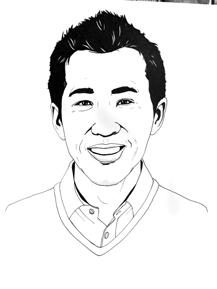
There is no medical test for ASD, so clinicians review a patient’s behavior — such as poor communication or struggles with emotional and social skills — and development to determine whether it meets the criteria of ASD.
Lee discussed what researchers know about vitamin D and autism and what expectant mothers should do with these findings.
30
Writing :
Q&A
Can autism be prevented through a healthy lifestyle of good diet and exercise?

LEE: Autism is a complex, multifactorial condition with both genetic and environmental determinants. My colleague Kristen Lyall, ScD, an assistant professor at the AJ Drexel Autism Institute, and I focus on identifying modifiable risk factors for autism, in the hopes that risk can be mitigated. Specifically, we target environmental factors like chemical or dietary exposures that perhaps can be modified to influence risk. Our work has shown, for example, that exposures to some factors during pregnancy, such as obstetric complications, infection and certain medications such as antidepressants may increase risk, while dietary aspects such as multivitamins, anemia and fatty acids can also influence risk. Vitamin D is often referred to as the “sunshine vitamin,” as the sun serves as our main source of this important substance in the body – but people can also get vitamin D in much smaller doses through a healthy diet.
So, what’s the takeaway here? Should women who are pregnant or may soon become pregnant run out to get vitamin D supplements right away?
LEE: Nutrition during pregnancy and early life can alter development of children in different ways, and our research suggests that lower vitamin D levels may increase risk of autism. This is consistent with a larger body of evidence indicating that higher vitamin D levels correspond with optimal neurodevelopment. And this is also part of a larger story of high levels of vitamin D insufficiency among pregnant women in the U.S. – depending on how you define insufficiency, between 33 percent to 70 percent of pregnant women have insufficient vitamin D. But this doesn’t translate to actionable evidence at this point.
For one thing, this study is an observational study and not a randomized controlled trial: more studies are needed. We don’t know if other factors influenced the findings, such as the possibility that healthier mothers who were at lower risk for having a child with autism tended to have higher vitamin D levels (although we controlled for such confounding to the best of our ability). We don’t know if our findings can be generalized to different populations – Sweden is notably different in terms of sunlight exposure from much of the world. And perhaps most importantly, nutrition is not necessarily as simple as popping a pill. We don’t know enough about aspects of timing and dosage in relation to
neurodevelopmental outcomes to even begin talking about supplements. Overnutrition is a potentially dangerous possibility. For example, high doses of vitamin A are known to cause congenital birth defects. Thus, more studies really are needed.
A JAMA Psychiatry study published in February of 241 children who have a sibling with ASD found that prenatal vitamins were associated with a reduced likelihood of ASD diagnosis. That study was also observational. How far is the field from a randomized controlled trial to find a causal link between vitamin D and ASD?
LEE: That study is consistent with our 2017 BMJ study and adds to an increasing body of evidence suggesting that such supplements might influence autism risk. I think that a randomized controlled trial is a high priority, but likely very difficult to conduct in an ethical fashion (i.e., the problem of randomizing pregnant women to specific diets) and in a way that produces clear results.
In the largest study to date on a link between vitamin D deficiency and ASD, the team looked at vitamin D levels in blood samples of mothers and more than 3,000 newborns in Sweden – 1,399 of whom were diagnosed with ASD. The authors found that higher levels of vitamin D were associated with slightly reduced risk of developing the condition.
20 20 VOL/
Social Leveraging
Educating parents about HPV through the power of social media
COMMUNITY HEALTH AND PREVENTION
WHAT WOULD IT TAKE to actually master the vast power of social media for public health — say, to assure parents of the overwhelmingly positive effect of having their children vaccinated against human papillomavirus (HPV), the most common sexually transmitted infection in the United States?
Twitter seems perfectly suited to both hinder and help. At least 75 percent of parents use social media, with a quarter of them on Twitter. Yet many parents are confused by mixed messages surrounding the HPV vaccine, and uptake lags well behind other childhood vaccines.
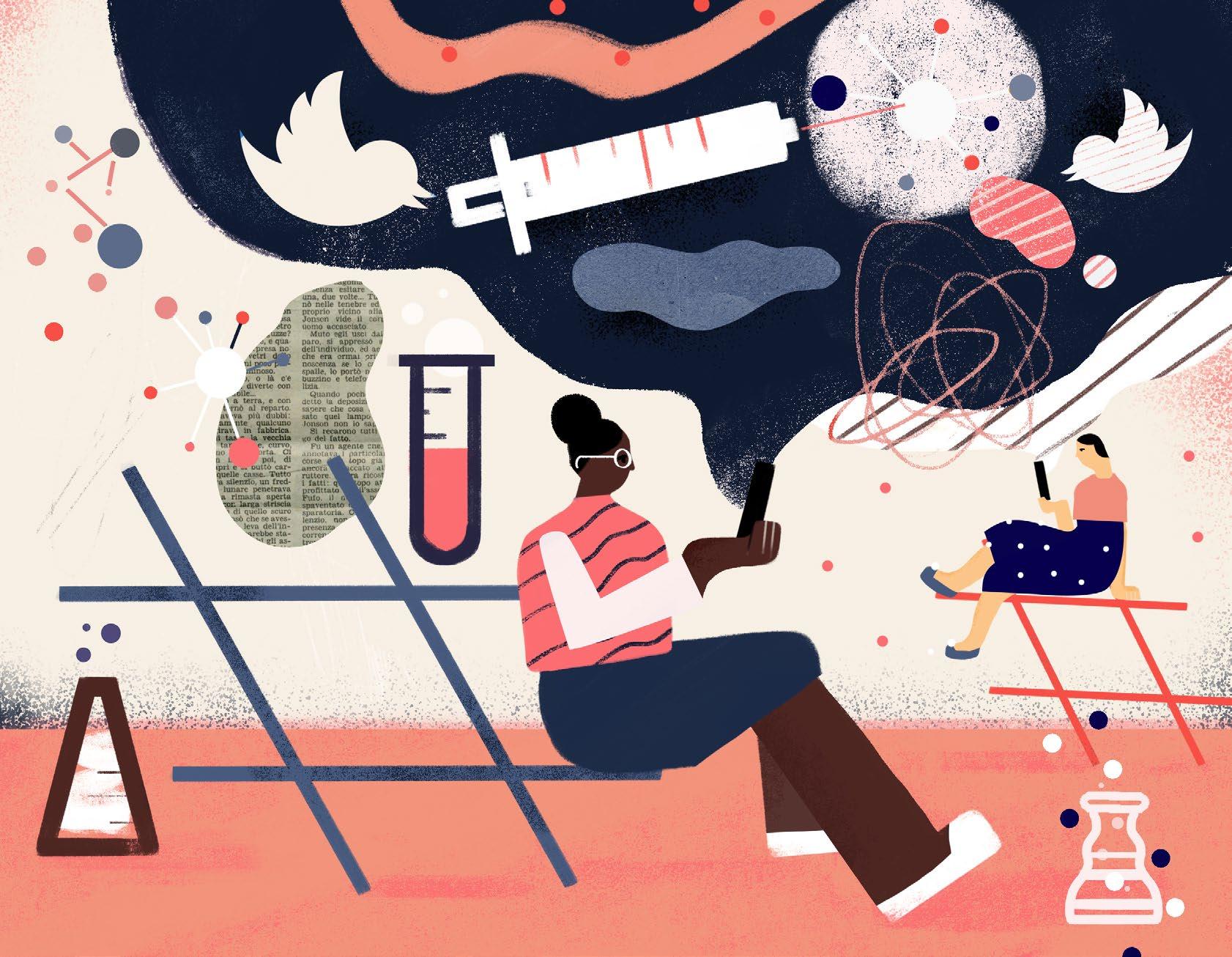
32
Featured
Positive, science-based messages about HPV vaccine, many of them posted by healthcare organizations and providers, are far more common than negative messages, Philip M. Massey, PhD, MPH, an associate professor in the Dornsife School of Public Health’s department of Community Health and Prevention, found in a study published four years ago. But the impassioned, highly relatable personal posts that are more likely to share misinformation can have outsize influence.
Public health has a lot of catching up to do.
Massey’s latest innovative study, now in its second year, aims to help the field leapfrog ahead. It will test the effectiveness of several more sophisticated uses of Twitter to engage parents through storytelling and increase the likelihood that they will have their child immunized against the virus.
The research team is designing characters (a mom, a dad, maybe a soccer coach) and storylines to create a series of narratives intended to draw and hold parents’ interest so they can take in evidence-based health information. The approach is informed by narrative engagement theory, which posits that narratives that communicate knowledge through characters “just like me” can have a powerful effect on behavior.


Rather than the “do this” messaging that is common from health authorities, these more nuanced stories will attempt to meet parents where they are: often overloaded with information, yearning for clarity and trying mightily to do what is best for their child.
A dad character in a narrative “might say ‘Yeah, I struggled with this and I got more information and wanted more than what I found so I talked to other parents and they were a mixed bag so I talked to my doctor, who said …’” Massey explains.
HPV vaccination, recommended for girls in 2006 and boys in 2011, has been controversial from the start, with some parents angered by the suggestion that their pre-teen girl needed to be immunized against a sexually transmitted disease. Meanwhile, nearly a quarter of Americans are infected. Most have no symptoms, but the virus is the most common cause of cervical, anal and oral cancers.
68 % Adolescents who currently receive vaccinations for protection against HPV. In comparison, more than 88 percent of adolescents receive vaccinations for Tdap and meningococcal, which are given at the same age.
PHILIP M. MASSEY, PHD, MPH Associate professor, Dornsife School of Public Health, Department of Community Health and Prevention
Enrollment will likely begin next year, with Twitter-using parents randomly placed into two groups as their child’s next doctor’s appointment approaches: 300 will receive the newly developed tweets; another 300 will get the kind of HPV messaging that is sent by the healthcare industry now.
Follow-up questions will measure engagement and self-reported vaccination. Researchers also will look at participants’ general Twitter use to try and determine characteristics that might lead someone to be more or less engaged.
Every part of the four-year study — enrollment, data collection, focus-grouping characters and storylines — will be online. There’s even a Twitter-based Community Advisory Board.
Massey has long worked at the intersection of public health communication, health literacy and emerging media technologies. His eventual goal with this study, which is supported by a $1.83 million grant from the National Cancer Institute is to make social media easier – and more effective – for providers.
“Health care professionals say, ‘I don’t want to start tweeting’ or ‘I’m not good at it,’” he says. Instead, he believes that entire campaigns could be created by hospitals and large health organizations and packaged for different stakeholders at different times. (Think seasonal, a baby’s six-month birthday.)
At the very least, Massey says, doctors could engage patients with a simple communication after an office visit: “Hey, if you have other questions, you may want to check out this Twitter account.”
33 20 20 VOL/
Don Spatikin Michela Buttignol Writing Illustration
Self Reflection
Transgender adults holding genderaffirming IDs have better mental health
HAVING GENDER-AFFIRMING documents, such as a passport, driver’s license, or birth certificate, may improve mental health among transgender adults, according to findings published in March 2020 in The Lancet Public Health titled, “GenderConcordant Identity Documents and Mental Health
Among Transgender Adults in the USA: A CrossSectional Study,” from researchers at the Dornsife School of Public Health.
“Having IDs that don’t reflect how you see yourself, and how you present yourself to the world, can be upsetting,” said lead author Ayden Scheim, PhD, an assistant professor in the Dornsife School of Public Health. “It can also potentially expose people to harassment, violence, and denial of service. Despite this, the relationship between gender-concordant ID and mental health had not previously been examined in the U.S.”
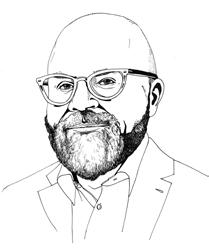
The study used data from 22,286 adults in the United States who participated in the 2015 U.S. Transgender Survey — conducted by the National Center for Transgender Equality — and were living day-to-day in a gender different from the one
EPIDEMIOLOGY AND BIOSTATISTICS
assigned at birth. Just under half — 45 percent — did not have their preferred name and gender designation on any identification documents, 44 percent had limited gender-concordant identification and just 10 percent had their preferred information on all documentation.
As compared to those with no gender-concordant identification, those with their preferred name and gender on all documents were 32 percent less likely to be classified as seriously psychological distressed, 22 percent less likely to have seriously considered suicide in the past year, and 25 percent less likely to have made a suicide plan in the last year.
This work is the first study in the United States to look at the connection between identification documents and improvements in multiple measures of mental health, including suicidal thoughts. A previous study from Canada found that, among trans men and women living full-time in their gender, having updated documentation lowered suicidal thoughts and attempts.

“The process, costs, and restrictions associated with updating identification documents vary from state to state,” said Scheim. “These roadblocks prevent many people from getting the documents they need.”
In addition to benefits in social interactions — such as ordering a drink in a bar — having ID is typically required to receive health care, obtain employment, open a bank account and other important aspects of life. The process for changing identification documents can vary greatly.
34
“Having accurate identification should be a fundamental human right. While many of us take it for granted, obtaining IDs can be very difficult for trans people.”
Featured
AYDEN SCHEIM, PHD Assistant professor, Dornsife School of Public Health
In addition to Scheim, authors on this paper include Amaya G. Perez-Brumer, PhD, of University of Toronto and Greta R. Bauer, PhD, of Western University.
California Rep. Ro Khana recently introduced a bill championed by transgender rights groups that would allow an unspecified or “X” option on a passport, in addition to the “M” or “F” genders currently listed. If the bill becomes law, this option would be available to any U.S. citizens identifying as nonbinary or intersex, even if their home state does not allow the X option on driver’s license or other state-issued IDs.
Although previous studies have looked into how medical gender affirmation procedures, such as hormones and surgery, impact mental health, very little is known about how legal identification affects mental health.
“Having accurate identification should be a fundamental human right. While many of us take it for granted, obtaining IDs can be very difficult for trans people,” Scheim said. “This is an area where tangible and relatively simple policy changes could aid public health.”
The researchers note that psychological distress and suicidal thoughts might have made it more difficult for participants to obtain updated identification, rather than the lack of identification leading to the poor mental health. Despite this limitation, the study’s data comes from the largest sample of trans adults ever surveyed and controls for other factors that could contribute to the connection between identification and mental health.

In light of this finding, the authors advocate for reducing or removing the barriers to changing gender and name on forms of identification, or possibly even removing the mention of gender.
“Beyond reducing barriers to changing gender and name on ID, we should be asking why gender needs to be indicated on photo ID at all,” Scheim said. “Including this attribute serves no clear purpose for identifying people — that’s what the photo is for.”
35 20 20 VOL/ Greg Richter Writing
Brian Stauffer Illustration
COMMUNITY HEALTH AND PREVENTION
The Science of Risk
Pathways to reducing HIV risk in Africa
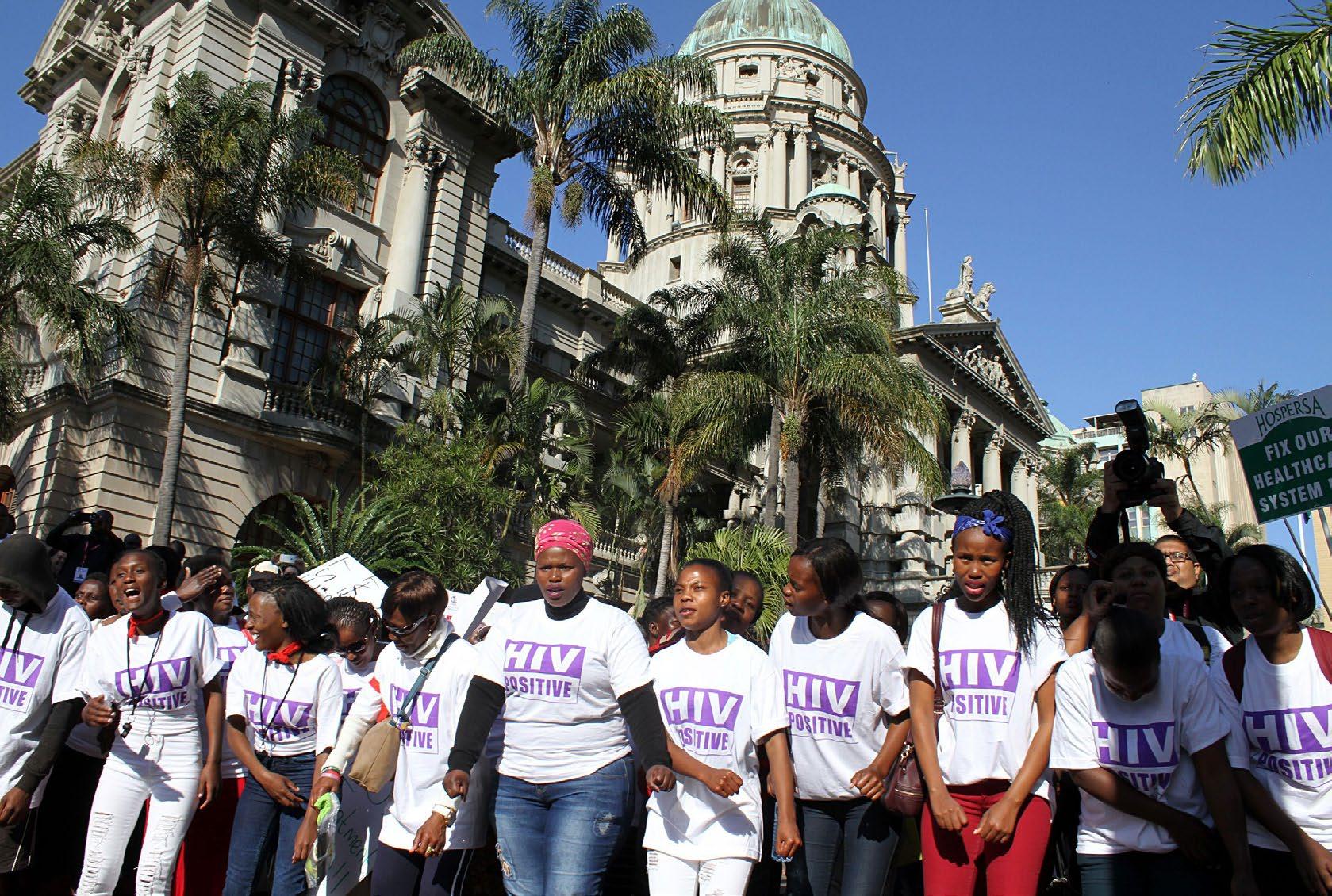
THE SEMESTER Allison K. Groves, MHS, PhD, spent studying in Zimbabwe as an undergraduate helped to chart the course of her professional life. “I became really aware of the feminization of the HIV epidemic,” she says, recalling the formative influence of steeping herself in another culture. “As someone interested in social justice, I wanted to understand how and why women were so disproportionately impacted.”
That experience put “fire in my belly,” she says, a flame that has never been extinguished. In the two decades since that first trip to sub-Saharan Africa, Groves, now an assistant professor of community health and prevention at the Dornsife School of Public Health, has dug into gender inequality and its influences on HIV risk and intimate partner violence from many angles. She focuses especially on pregnant and post-partum women.
36
Featured
TKTKTK GETTY IMAGES
“There are really significant gender disparities in HIV in subSaharan Africa,” she explains, noting that women under the age of 24 are at especially high risk, and that the young mothers within that population face greater danger still. “One thing that drives HIV infection in the region is intimate partner violence, and younger women are more likely to report that.”
In her most recent study, published in the Journal of Adolescent Health in January 2020, Groves characterizes the sexual relationships forged by adolescents (under age 18), young adults (18 to 24) and adult women (25 to 45) in South Africa who have recently given birth and explores their risks for HIV.

The distinctive feature of her research design is that it considers how a woman’s age at pregnancy may affect her relationship dynamics. “I was interested in thinking about age as a marker of power,” explains Groves. “We always think about age as something to control for. We don’t really think about how age itself tells us something meaningful about where a person is developmentally and what their power might look like.”
Groves drew on a subset of data from a South African randomized controlled trial of counseling and testing services designed to reduce HIV risk after delivery. The smaller sample included HIVnegative pregnant women who had been with their partners for at least six months.
True to her hypothesis, Groves found significant differences across the three age categories. A key finding is that adolescents had less stable and newer relationships than either of the other older groups and were much less likely to be married or living with a partner. None had intended to get pregnant and almost all of them were first-time mothers. At 14 weeks postpartum, the adolescents also scored higher than older women on a number of measures of HIV risk, including a belief that their partners may have had other sexual encounters since their children were born.
As well, adolescents and young women were significantly more likely to have experienced physical violence from intimate partners following delivery (17 percent, compared to 8 percent of the older women). And, based on measures from a well-established scale, adolescents have less decision-making control within their relationships.
“Power dynamics in a relationship affect an individual’s ability to negotiate sex,” points out Groves, explaining the link to HIV risk. “A woman with less power in her relationship might have less ability to negotiate whether or not she wants to have sex or to insist that a condom be used.”
“Adolescents, in particular, were in less stable, more power-inequitable relationships with high-risk partners... with whom they had not planned their first pregnancy.” (Groves et al., Journal of Adolescent Health, January 25, 2020)
One other intriguing finding from her study hints at a possible pathway to reducing HIV risk: only 21 percent of adolescents said they had resumed having sex 14 weeks after delivery, compared to almost 60 percent of women in the other age groups. “That is not surprising because their pregnancies were all unintended and
they were all pregnant for the first time,” observes Groves. “From an actionable perspective, there is a critical opportunity to provide an intervention; we can use that time to prepare them before they have sex again. It’s a nice window.”
As a springboard for action, the variation across age groups points to the importance of custom-tailored responses. “Adolescent mothers need unique interventions,” Groves points out. “They are in a different life space than older mothers.”
Up next for Groves is writing a research grant to test strategies for reducing HIV risk among adolescents. While she is still designing the interventions, she is especially focused on strategies that address conflict and stress. “It’s really around communication, negotiating, and conflict resolution,” she says. Because poverty and lack of education are linked to HIV and intimate partner violence, tools to address social and structural determinants of health outside clinic settings are also essential, she notes.
Targeting intimate partners who perpetrate violence is also a priority for Groves. While recognizing the value of projects to support women threatened by violence, she is interested in a broader context. “I haven’t developed and tested an intervention that specifically targets reducing violence with the women themselves, partially because I think they are the wrong target,” she says. “What is driving the men to perpetrate the violence? Addressing those things might have a bigger impact.”
As the science of HIV risk moves forward, scholars like Groves are also considering another causal connection: might an HIV-positive status increase a woman’s vulnerability to violence? By teasing out the direction of those kinds of dynamics, they remain on the cutting edge of a field where measurable progress is being made — and great strides remain to be taken.

37 20 20 VOL/
Karen Feiden Writing
Hundreds of AIDS activists march through the streets of Durban during the 21st International Aids Conference in 2016.
ALLISON K. GROVES, MHS, P h D Assistant professor of community health and prevention, Dornsife School of Public Health
ALL HANDS ON DECK
Through service, outreach, research, and advocacy, Dornsife faculty, staff, and students are taking unprecedented action amid the coronavirus pandemic.
BY EMILY GALLAGHER
ILLUSTRATIONS BY JON KRAUSE

THE NOVEL CORONAVIRUS, also known as SARS-CoV-2, which causes the coronavirus disease 2019 (COVID-19), has altered life globally. What began as reports of a mysterious cluster of pneumonia in Wuhan, China, in December 2019, transformed into a widespread pandemic that the world is trying to understand and grapple with daily. ¶ At the start of March 2020, the federal government declared a national emergency in the United States. Across the country, unprecedented prevention measures were enforced like the closing of public spaces and businesses, stay-at-home orders, 6-feet social distancing, and mask-wearing initiatives to contain the spread from person-to-person. The use of epidemiological language like “flatten the curve” and “contact tracing” and regular press briefings led by public health leaders became the new normal. ¶ Despite efforts by local government officials and public health leaders — some more proactive than others — to stop the spread of coronavirus, the number of cases in the United States approached 8 million and the number of deaths had surpassed 220,000 by the end of October 2020. ¶ In addition to the loss of life, the pandemic has created an economic crisis that has left many jobless, without medical insurance, experiencing housing and food insecurity. The crisis has many ripple effects that will have long-term impacts on the health and wellbeing of populations. ¶ In these uncertain times, the Dornsife School of Public Health community has taken action demonstrating the importance of public health and the contributions of public health professionals through supporting local communities, conducting research, advocating for health equity, and sharing expertise.

SERVING OUR
FROM THE FIRST REPORTED CASE in March to October 2020, there have been more than 150,000 confirmed cases of COVID-19 in Pennsylvania. Due to a higher population density and social conditions that make communities more at risk for infectious diseases like COVID-19, Philadelphia County has been hit harder than other counties in Pennsylvania. Furthermore, mortality rates were substantially higher among Black and Hispanic people living in segregated neighborhoods throughout the cities.
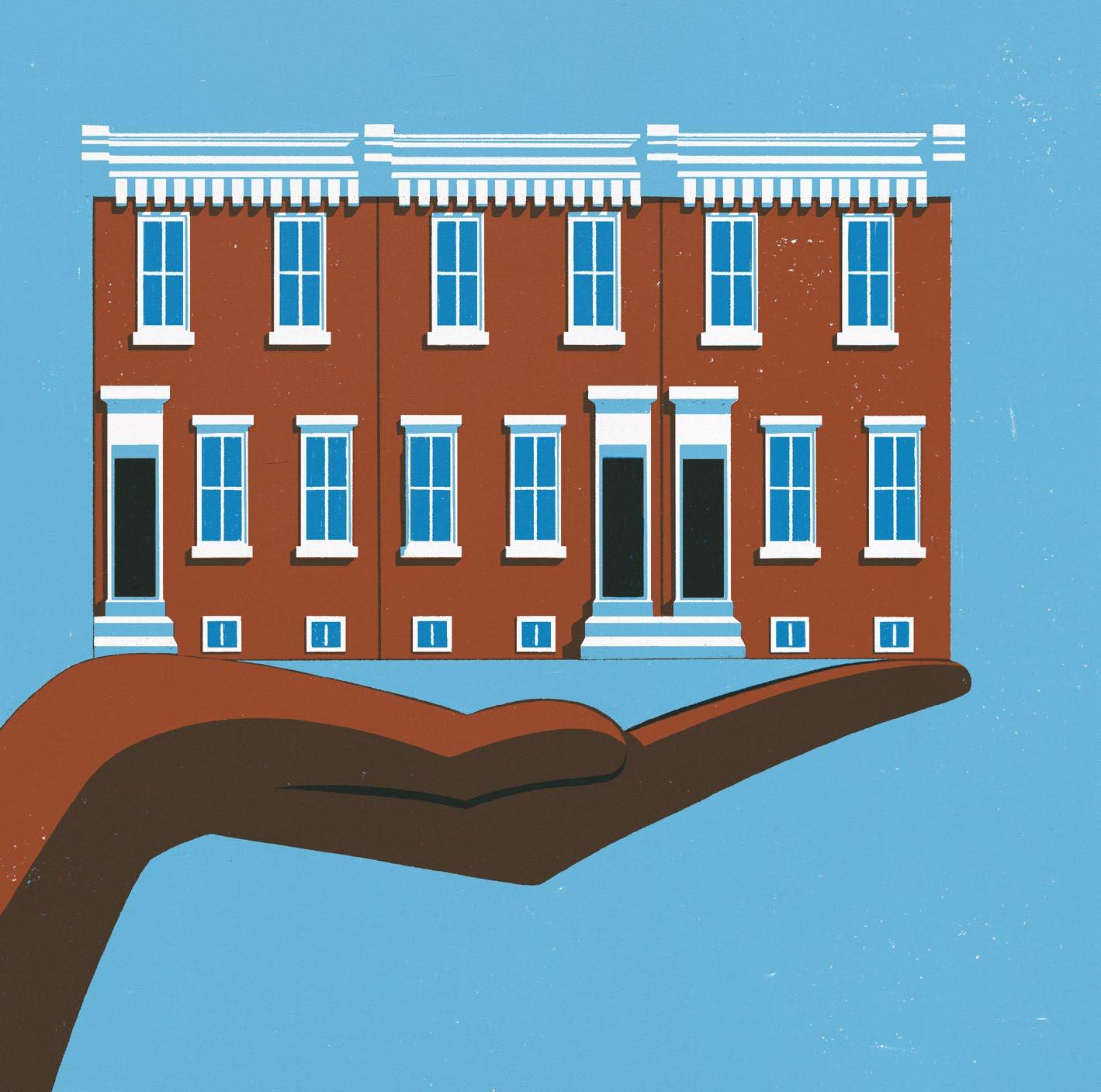
Faculty, staff, and students confronted these challenges head on to mitigate adverse outcomes of the pandemic in communities across the city.
As members of the City of Philadelphia’s Board of Health, Ana V. Diez Roux, MD, PhD, MPH, dean and distinguished university professor of epidemiology, Marla Gold, MD, professor of health management and policy and vice provost for community health care innovation, and John Rich, MD, MPH, professor of health management and policy, have been helping develop strategies to respond and protect the health of residents with the Philadelphia Department of Public Health (PDPH) and Health Commissioner Thomas Farley, MD, MPH. “We have been in touch with Commissioner Farley and the PDPH periodically and have offered the services of our School for whatever he needs,” said Dean Diez Roux.
Rich also sits on PDPH’s Health Equity in COVID-19 Advisory Panel with Usama Bilal, MD, PhD, assistant professor in the department of Epidemiology and Biostatistics and the Urban Health Collaborative (UHC) at Dornsife.
In early March, Ana Martinez-Donate, PhD, professor in the department of Community Health and Prevention at Dornsife, coordinated what became an ongoing series of biweekly town hall meetings with representatives from Latino-serving organizations like Congreso, Esperanza Health Center, the Consulate of Mexico, Puentes de Salud, HIAS Pennsylvania, and the CRISOL Program. Together, the group identified important issues, discussed possible solutions, and shared resources to help alleviate them.
What started as a small group of organizers transformed into what is known as the “Latino Health Collective” with policymakers, public health professionals, city officials, and representatives from more than 40 different Latino-serving organizations.
One of the first hurdles the Collective addressed was insufficient access to testing and language barriers to healthcare that were common among Hispanic communities. To remedy these issues, the Collective advocated for communities by alerting the City of Philadelphia’s Department of Public Health (PDPH), which resulted in the PDPH setting up testing sites in South Philadelphia. They also advocated to ensure local hospitals provided translation services for Spanish speaking patients seeking COVID-19 care.
Thanks to the support of numerous doctoral and master’s program students from Dornsife, Martinez-Donate has been able to expand her reach to communities in this challenging time. “As a group, we rolled up our sleeves and promoted solidarity and inter-organizational collaboration. It’s gratifying,” she said.
As details of the Philadelphia School District’s plan to reopen schools virtually were released throughout the summer, the Collective planned meetings centered around challenges that families would face. From a lack of Internet and technology access to concerns about childcare, the Collective worked together to create a dialogue and problem-solve once again.
To support communities surrounding Drexel University in West Philadelphia, the Dornsife-led West Philadelphia Promise Neighborhoods (WPPN) project team acted fast. WPPN, whose mission is to support children who live or attend school in designated neighborhoods, engaged with families to gather their feedback on COVID-19 triggered issues and implement strategies to keep residents safe.
CITY
When the City of Philadelphia urged residents to wear masks in all indoor public places in April, the WPPN supplied protective masks for essential workers.
As schools closed their doors, the staff at WPPN learned that many students were missing the two free meals they usually received at school. In response, WPPN set up meal pickup sites throughout the community where families could access free meals. At these sites, they also distributed communication materials they developed to educate the community about the risks associated with COVID-19 and healthy practices.
In South Philadelphia, Esther Chernak, MD, MPH, FACP, associate professor of environmental and occupational health, director, Center for Public Health Readiness and Communication at Dornsife, and her team assisted in the planning of a COVID-19 drive-thru testing facility at Citizens Bank Park in March. The site was open for two months and was created to provide testing to potentially more vulnerable individuals over the age of 50. At this testing facility, Jennifer Kolker, MPH, clinical professor and associate dean for public health practice and external relations at Dornsife, along with several Dornsife students volunteered.
In addition to adjusting to online learning, students not only volunteered, but they also worked on coronavirus-specific projects.
Afrah Howlader, BS ’21, worked with First Up, a nonprofit that empowers early childhood educators in the Delaware Valley with resources and support, to gather legislative support of essential childcare funding during the pandemic.
Through Dornsife’s Office of Public Health Practice, several students were given consulting projects to help companies and organizations like the City of Philadelphia’s Office of Children and Families, Neuroflow, and the HealthSpark Foundation develop solutions to emerging COVID-19 issues.
Sydney Stern, MPH ’21, interned at the United States Environmental Protection Agency (EPA) to map the incidences of environmental exposures like air pollution and reported COVID-19 cases throughout Philadelphia County to track correlations and identify communities with a higher risk of contracting the disease.
“My experience with the EPA allowed me to have a positive impact on the COVID-19 pandemic in real-time and increase my knowledge about the role of a government agency like the EPA in a pandemic,” said Stern.
The Dornsife community is committed to providing continued support to local communities.
41
“As a group, we rolled up our sleeves and promoted solidarity and interorganizational collaboration.”

CONDUCTING RESEARCH
AS THE PANDEMIC PROGRESSED , many Dornsife researchers rapidly pivoted their research endeavors to meet the moment. From tracking COVID-19 inequities in testing to assessing mental health among first responders, Dornsife researchers have been busy in varied and important ways.

As cases of COVID-19 began to hit Philadelphia, Bilal began tracking the distribution of testing throughout the city with an eye towards measuring equity. His research found that neighborhoods with a higher number of unemployed or uninsured people had less testing. Also, zip codes with a lower proportion of Black and Hispanic people and higher incomes generally had a higher number of tests per capita.
“Any difficulty in controlling outbreaks for a specific group is a failure of the entire society. In a pandemic such as this one, we either have the disease under control for everyone, or we don’t have it under control for anyone,” said Bilal. “Understanding where and why testing is working less effectively is key to helping control the pandemic, both locally and nationally.”
Bilal’s research on these disparities gained local, national, and international attention in outlets such as ABC News, The New York Times, and Guardian News.
Sharrelle Barber, ScD, assistant professor in the department of Epidemiology and Biostatistics at Dornsife and the UHC, led a team of faculty and students that highlighted the role of structural racism and inequality in shaping the impact of the pandemic. The team developed a brief titled, “COVID-19 in Context: Racism, Segregation, and Racial Inequities in Philadelphia,” that described how and why Black people were being disproportionately burdened by coronavirus in cities like Philadelphia. It focused on the mechanisms through which interlocking systems of racism, inequality and segregation drive exposure to the virus, infection rates, and the severity of COVID-19 disease. The brief included a broad set of recommendations supported by prior work.
Irene Headen, PhD, MS, assistant professor in the department of Community Health and Prevention, and Loni Philip Tabb, PhD, associate professor in the department of Epidemiology and Biostatistics, Breauna Branch, an MPH program student at Dornsife, and
Kenna Yadeta, a recent MPH program graduate, were coauthors on the brief.
“This brief allowed us to highlight racial inequities not in an anecdotal fashion but grounded in a strong theoretical framework with epidemiological and biostatistical methods that ensure the rigor necessary to produce this evidence,” said Tabb.
If the nation’s public health authorities had viewed the coronavirus from the beginning through “a lens that has structural racism as a driver,” Barber said, they would — or could — have known where to focus testing and prioritized PPE for essential workers.
Barber’s analysis linking structural racism to COVID-19 disparities has been extensively covered as well by publications like The New York Times, Al Jazeera, Smithsonian, and Medium
In collaboration with the Big Cities Health Coalition (BCHC), the UHC developed estimates and infographics on the number of lives saved due to stay-at-home orders in 30 major metropolitan areas in the United States. Using a model published by The New York Times, the UHC calculated that stay-at-home orders led to an estimated 2.1 million hospitalizations avoided and more than 200,000 lives saved in a span of the first 45 days of most stay-at-home orders.
When stay-at-home order fatigue seemed to set in, policymakers like Pennsylvania Governor Tom Wolf, Philadelphia Mayor Jim Kenney, and Health Commissioner Tom Farley — as well as governmental leaders across the country — referenced the estimates to underscore the effectiveness of these policies and promote continued caution.
43
If the nation’s public health authorities had viewed the coronavirus from the beginning through “a lens that has structural racism as a driver, they would – or could – have known where to focus testing and prioritized PPE for essential workers.
“The goal of this project was to remind people that in this situation, doing nothing was doing something,” said Jennifer Kolker, MPH, clinical professor and associate dean for public health practice and external relations at Dornsife. “We wanted to give cities the opportunity to tell their residents something positive and feel good about their collective action in the COVID-19 response.”
Collaboration with the BCHC is continuing as the demand for city-level data is needed. UHC researchers, with funding from the Robert Wood Johnson Foundation, are currently tracking outcomes and inequalities of the pandemic across major cities in order to provide timely and relevant data for local policy-makers as they develop strategies and policies to address the pandemic and reduce inequities. While other platforms exist at the state and county level, this platform will be unique to the city-level.
To specifically help the hardest-hit neighborhoods in Philadelphia, Amy Carroll-Scott, PhD, MPH, associate professor of community health and prevention, and Félice Lê-Scherban, PhD, MPH, assistant professor of epidemiology and biostatistics, both at Dornsife and the UHC, created an interactive data tool designed to inform COVID-19 response and recovery efforts. The tool provides data on socioeconomic conditions, housing, and transportation access by region to accurately assess vulnerabilities and needs.
“Our dashboard translates the important health equity lens to COVID-19 recovery by putting practical information into the hands of Philadelphia decision-makers and community leaders to ensure limited resources are being allocated to those who need it most,” shared the researchers.
In an effort to collect feedback directly from residents of Philadelphia during this time, Igor Burstyn, PhD, associate professor, and Tran Huynh, PhD, MPH, CIH, assistant professor, both in the department of Environmental and Occupational Health at Dornsife, circulated a city-wide survey. The survey specifically examined how people’s work and health (physical and mental) were changing.
“We are all affected by COVID-19 to some degree and are coping in different ways,” says Burstyn. “The aim of our work is to document experiences so that common threads that emerge can help us be more resilient now and in the future.”
The survey data are being analyzed and are anticipated to be shared widely in late 2020. Several ongoing research projects at Dornsife were selected to receive funding either privately or as a part of Drexel’s Rapid Response Research & Development Fund, which was designated for urgent action and health-related research and development.
RESEARCHERS ARE ENGAGED IN THE FOLLOWING WORK:
BILAL received funding from the National Institutes of Health in September 2020 to research disparities in COVID-19 testing, rates of infection, and mortality among Hispanics across 30+ U.S. cities.
JONATHAN PURTLE, DRPH, MSC , associate professor of health management & policy, received a grant from the National Institute of Mental Health in August 2020 to study the impact of the pandemic on public mental health systems’ services for children and families.
BURSTYN AND NEAL D. GOLDSTEIN, PHD, assistant research professor of epidemiology and biostatistics at Dornsife, are conducting research on how inaccuracies in current polymerase chain reaction (PCR) tests affect estimates of the number of COVID-19 cases.
ALI GROVES, PHD, MHS, assistant professor of Community Health and Prevention at Dornsife, is conducting in-depth interviews with low-income residents in Connecticut in hopes to provide insights for key decision makers.
JENNIFER A. TAYLOR, PHD, MPH, CPPS , director, Center for Firefighter Injury Research and Safety Trends (FIRST), and the Arthur L. and Joanne B. Frank Professor of Environmental and Occupational Health at Dornsife, is leading a study on the assessment of first responders’ mental health during the pandemic.
ALEXIS ROTH, PHD, MPH, associate professor of community health and prevention, is conducting a study that compares treatment outcomes for opioid use disorder before and after the COVID-19 outbreak in Philadelphia.
ADVOCATING FOR POLICY INITIATIVES
DORNSIFE WAS FOUNDED on the principle of health as a human right. With that mission in mind, Dornsife experts have urged government officials to consider new legislation, policies, and spending that address inequities and protect the health and human rights of everyone in the country, including the most vulnerable during this time.
In April 2020, Barber and Shiriki K. Kumanyika, PhD, research professor of community health and prevention at Dornsife, urged government officials and health providers to not only release Pennsylvania’s figures on COVID-19 and race, but to share specific geographic data.
County-level figures without information on case numbers by zip code or municipality can be problematic. “We’re not wanting data for the sake of data,” Barber said. “We’re wanting data so we can mitigate
44
“We need to make sure that the entire population is wellnourished and taken care of, not just because it’s the morally right thing to do. It’s so we don’t get sick.”
this disproportionate impact in certain communities and come up with short- and long-term policy solutions to save lives.”
As unemployment skyrocketed across the United States, Mariana Chilton, PhD, professor of health management and policy and director of the Center for Hunger-Free Communities at Dornsife, has been advocating in the media for Congress to expand relief programs, like SNAP benefits, so people do not have to choose between food and basic necessities. “We need to make sure that the entire population is well-nourished and taken care of, not just because it’s the morally right thing to do. It’s so we don’t get sick,” said Chilton.
Joe Amon, PhD, MSPH, clinical professor of community health and prevention and director of the Office of Global Health at Dornsife, along with
the ACLU of Pennsylvania, the Abolitionist Law Society and the Amistad Law Project, urged Pennsylvania Governor Tom Wolf to reduce inmate populations amid the coronavirus outbreak in March. Together, they communicated the unique challenges for correctional facilities and the risks associated with not reacting. “There was too limited of a response to prevent transmission in detention centers, including jails, prisons, and immigration detention facilities,” said Amon.
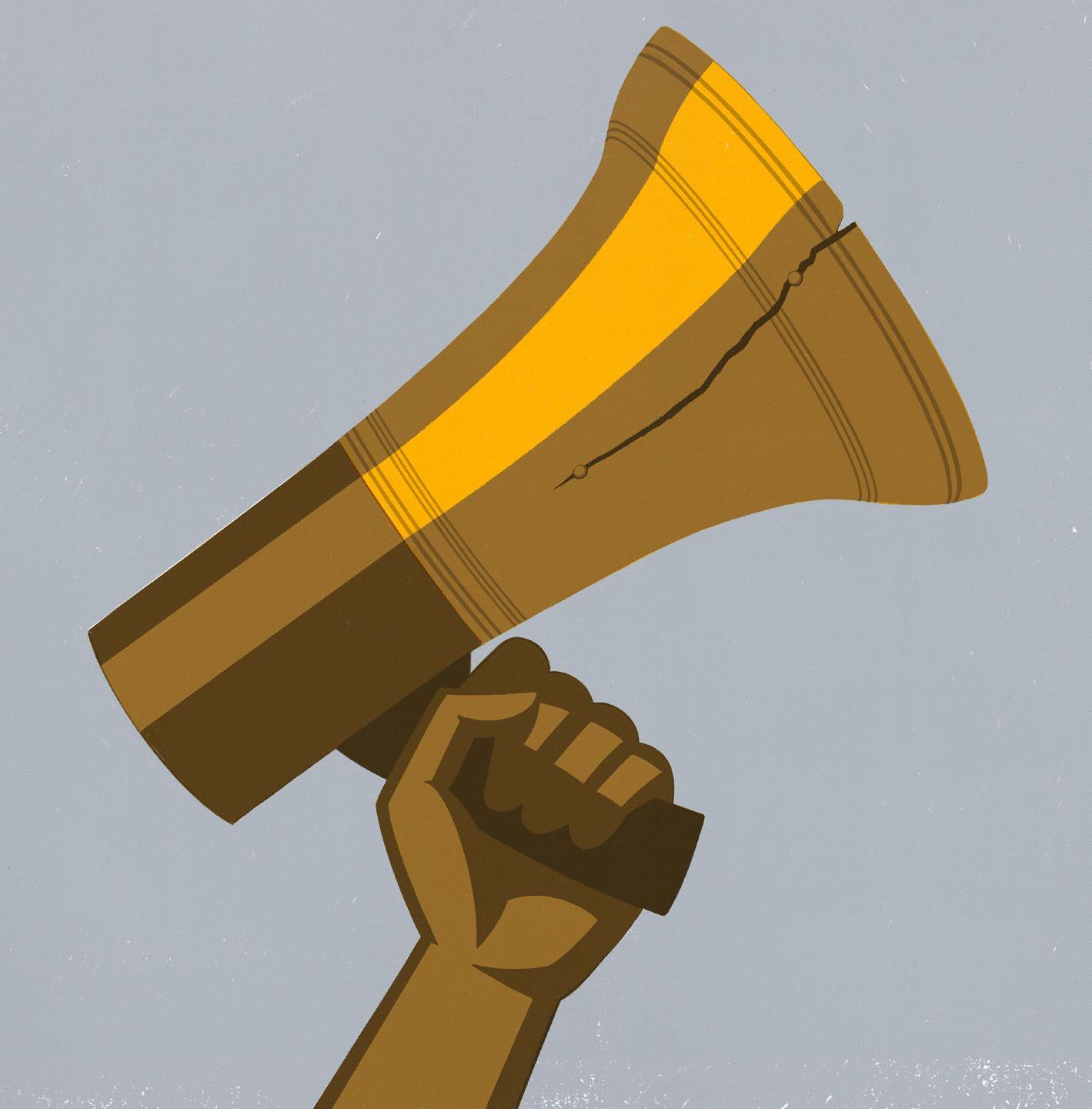
Also in early March, Amon, Diez Roux, and Robert Field, PhD, MPH, professor with a joint appointment at Dornsife and Drexel’s School of Law, joined more than 450 fellow public health and law experts to issue guidelines for the United States’ response to coronavirus transmission. The open letter detailed a series of recommendations that government officials should consider.
Stepping in to advocate for policy and funding that protects health have and will continue to be a priority at Dornsife.

For more information on Dornsife’s response to COVID-19, visit the School’s dedicated coronavirus webpage at bit.ly/DSPHcovid19updates
PROVIDING FACTS
DORNSIFE FACULTY AND RESEARCHERS have risen to the public’s demand for informed public health analysis.
Dornsife faculty experts have been called on by the media to provide insights on public health practice, disparities, and urban health in relation to coronavirus in more than 350+ news items in publications like The New York Times, HuffPost, CNN, CNBC, NPR, FOX, USA Today, and more.
Barber, Bilal, Diez Roux, Chilton, Rich, Amon, and Alex Ortega, PhD, professor of health management and policy Dornsife, have each helped raise awareness in the media about COVID-19 health disparities or human rights concerns that need to be addressed. Notably, Barber was quoted in a New York Times piece titled “Black Americans Face Alarming Rates of Coronavirus Infection in Some States.” The story was also picked up by USA Today, CBC, and various CBS and Fox local channels.
Goldstein, Thersa Sweet, PhD, MPH, associate professor, Michael LeVasseur, PhD, MPH, assistant teaching professor, Yvonne Michael, ScD, SM, associate professor, Seth Welles, PhD, ScD, professor, Jane Clougherty, MSc, ScD, associate professor, each in the department of Epidemiology and Biostatistics at Dornsife, and Chernak have worked with journalists repeatedly to answer commonly asked questions about COVID-19 and even helped to debunk common COVID-19 myths.
To provide further timely, tangible information to the public, Dornsife introduced a webinar series, “Emerging Issues in the Coronavirus Pandemic.” The weekly webinar series ran from March-May 2020 and featured individuals who specialize in emergency preparedness, urban health, clinical trials and treatments, global health, health equity, and more. The first installment of the series attracted more than 6,000 viewers in total.
In September 2020, the webinar series began again with experts updating viewers on the latest news and the implications of the pandemic.
Experts from Dornsife have even provided guidance to our youngest community members, helping children process their questions and fears about the pandemic.
James Buehler, MD, clinical professor and interim chair of the department of Health Management and Policy at Dornsife, participated in a series of interviews with middle school students where they asked questions about the pandemic and its impact. These interviews were hosted via Healthy NewsWorks, a nonprofit that empowers elementary and middle school students to become researchers, writers, critical thinkers, and confident communicators who advance health understanding and literacy through their factual publications and digital media, of which Buehler is a board member.
NOT FEAR
For a younger audience, Goldstein co-authored two books scheduled for release in February 2021 titled “Pandemics for Babies” and “Germ Theory for Babies.”
In hopes to minimize the spread of misinformation and fear, Dornsife experts are sharing expertise whenever possible, both locally and nationally.

To see all upcoming and past webinars in the “Emerging Issues in the Coronavirus Pandemic” series, visit bit.ly/ DSPHwebinars.
FACING THE FUTURE
As COVID-19 continues to disrupt global health, the School remains focused and committed to being part of a meaningful and effective response. Now more than ever, having accurate coronavirus data to inform public health practice and improve population health is essential. The Dornsife community is sharing facts, using public health expertise to guide and support the best strategies, and working together to face new challenges and inequities caused by COVID-19.
47

THE OFFICE OF PUBLIC HEALTH PRACTICE at the Dornsife School of Public Health held its first annual Public Health Student Case Competition in January 2020. Led by Caroline Voyles, MPH, director of Student Placement and Partnership Development at Dornsife, undergraduate and master’s students in eight interdisciplinary teams were tasked with finding solutions to mitigate the potential negative public health impacts of the 2019 Hahnemann Hospital closure in Philadelphia. They investigated different populations that are impacted by the closing, identified specific risks, and proposed plans that were specific to Philadelphia with the city’s unique challenges.
(continued)

49 DORNSIFE
Highlights
MPH students
20 20 VOL/
Alesha Amin, Mitali Aralekar, Deja Moore and Armonie Pierre-Jacques display their Case Competition award.
“It was great to use the knowledge we had learned from the classroom to solve a real-world problem,” says Shannon Kelleher, MPH Epidemiology ’20. “Working together with classmates from other disciplines was also a fulfilling experience.”
Teams were given one week to collaborate and work with one another before presenting to a live audience and expert judge panel of faculty and local public health practitioners for a chance to win prize money. During this work period, students were able to meet with their randomly assigned faculty mentor for guidance and support.
At the standing-room only event, each team presented for 10 minutes and participated in a five-minute Q&A with the judges. Audience members included faculty, staff, students, external partners, and family and friends of the competitors. After presentations, all were welcomed to a reception where the winners were announced and presented with their prizes.
After carefully tallying the scores, the judges selected Team Four — Kelleher, Katherine Castro, MPH Epidemiology ’20, Nicole Mertz, MPH Community Health & Prevention ’20, Farren Rodriques, MPH Community Health & Prevention ’20, and Alex Trautman, MPH Community Health & Prevention ’20 — as the winners and Team Seven — Alesha Amin, MPH, Community Health & Prevention ’21, Mitali Aralekar, MPH Environmental & Occupational Health ’21, Deja Moore, MPH, Health Management & Policy ’21, and Armonie Pierre-Jacques, MPH, Community Health & Prevention ’21 — as the runners-up. The winning team received $500 per member and the second-place team received $200 per member.

“It felt wonderful to feel like our ideas were supported and recognized as effective potential solutions to the closing of Hahnemann,” says Kelleher. “The diversity of the judges in terms of being faculty and non-faculty also gave us assurance that our solutions were supported by the community as well.”
The organizers look forward to hosting the Case Competition annually. “After witnessing the teams’ thoughtful approaches to the inaugural competition scenario, I’m very excited about the future versions of this event,” says Voyles. “I cannot wait to see students pull from their various courses and public health experiences to develop a solution, as you need all knowledge and skills from all aspects of public health to enact meaningful, lasting change for the better.”
In Nesbitt Hall, Dornsife students took the microphone to present their public health solutions to peers, faculty, and staff.


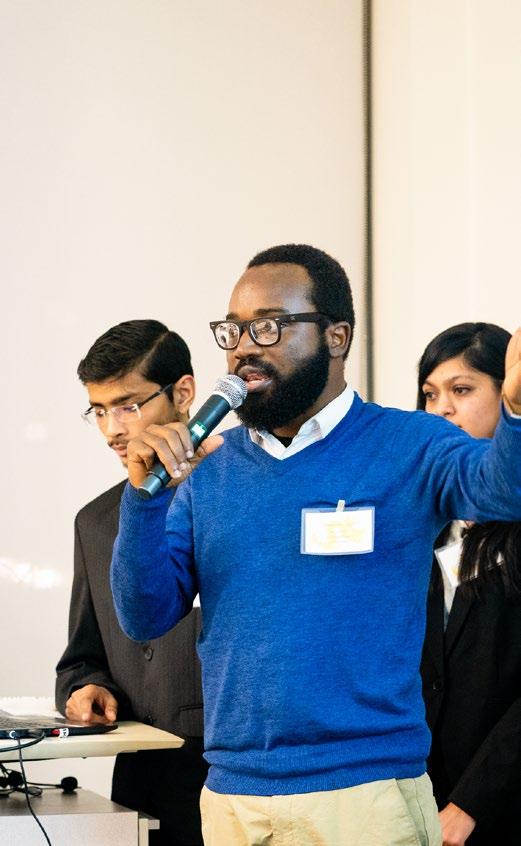
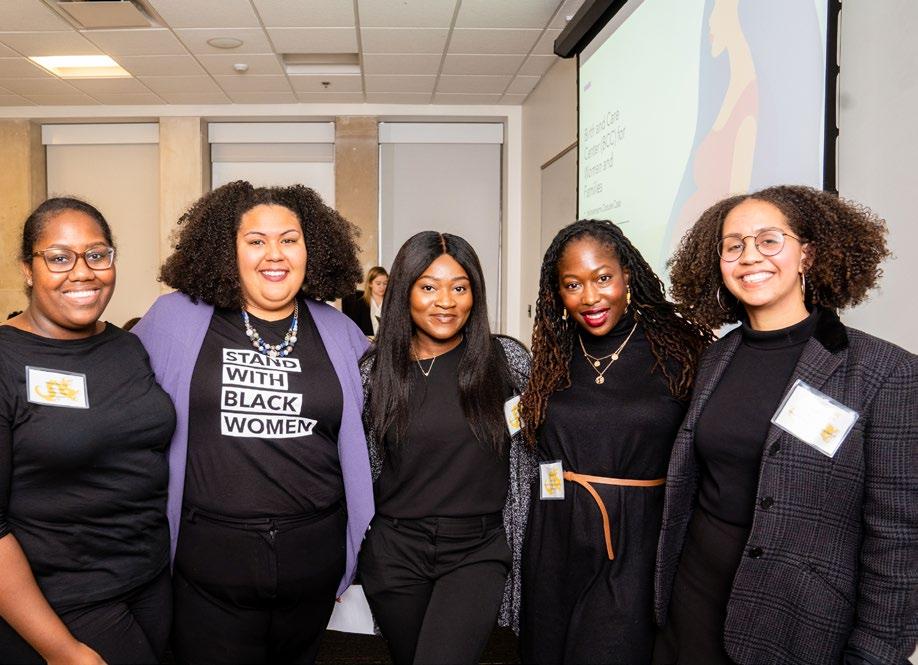
50
Highlights DORNSIFE
Michael L. Jenkins, Jr, MPH ’12, has been working for the Substance Abuse and Mental Health Services Administration (SAMHSA) in the Washington D.C. metro area for more than a year now as a Special Assistant to the Director of the Center for Substance Abuse Treatment. He recently began the DrPH program at Johns Hopkins University.
Marissa Leahy, BS ’18, has been working as a Disease Intervention Specialist at the Philadelphia Department of Public Health in their STD Control Program for more than a year now.
Starting in March 2020, Garrett Devenney, MPH ’18, was promoted to Health Policy Advisor for Senator Patty Murray (D-WA) and the United States Senate Health, Education, Labor, and Pensions (HELP) Committee. Before this role, he worked in the Office of United States Senate Democratic Leader Charles E. Schumer.

Signe Espinoza, MPH ’19, became the Director of Policy at Planned Parenthood Pennsylvania Advocates in February 2020. She is responsible for leading Planned Parenthood Pennsylvania Advocates to achieve its legislative and policy goals related to sexual and reproductive health.
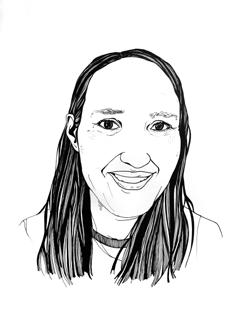
John Marshall, MPH ’19, launched a Philadelphia-based granola business with products called OTbar and OTbites that are made with simple, healthy ingredients and are sold throughout the city. To give back, 10 percent of the profits are donated to Philabundance, the region’s largest hunger relief organization. Learn more and order at otbars.com.
In July 2020, Maura BoughterDornfield, MPH ’20, began working as a Research Assistant at Public Health Management Corporation, a nonprofit public health institute that builds healthier communities through partnerships with government.

In March 2020, Amanda Hazen, MPH ’20, was hired full time as a Data Linkage Epidemiologist at the City of Philadelphia’s Department of Health (PDPH). While pursuing her degree at Dornsife, she interned at PDPH analyzing injection related infections in Philadelphia acute care hospitals and presented results to epidemiologists in the Opioid Program.
After completing her degree, Katie LaWall, MPH ’20, accepted an offer at the Centers for Disease Control and Prevention’s Council of State and Territorial Epidemiologists (CSTE) as an Applied Epidemiology Fellow at the Connecticut Department of Public Health. She began the fellowship remotely in August 2020.

51 20 20 VOL/ ALUMNI NOTES
Amber Tirmal, MPH ’09, is an Immunization Program Manager at the Public Health Management Corporation. When coronavirus first hit Philadelphia, Tirmal and her team coordinated quarantine sites across the Greater Philadelphia area and helped ensure people experiencing homelessness had a safe space to occupy during the pandemic . Now, she is planning for the eventual distribution of a COVID-19 vaccine.
AMBER TIRMAL, MPH ‘09
Melissa Kauffman
In order to get people more used to the idea of online learning, before the pandemic, Kauffman took the time to help faculty baby-step into it by launching a certificate in public health last fall. The program adapted for online all the core courses that every MPH student takes.
EXPANDING ONLINE LEARNING OPPORTUNITIES AT DORNSIFE
Melissa Kauffman, director of academic innovation for the Dornsife School of Public Health, was busily boosting the university’s online presence even before COVID-19 hit.

Dornsife introduced four new online master’s programs in the field of public health: MPH in Urban Health, MPH in Global Health, MPH in Epidemiology and MS in Global Health. These fully online programs began accepting applications for Fall 2020 admission in spring 2020.
Up until recently, Dornsife had a much smaller online presence, with four online certificate programs of 9 to 18 credits. But as director of online learning for Dornsife, Kauffman’s role until late fall, she worked her magic, using a combination of instructional design, project management, and strategic planning to collaborate with faculty and program directors to create online courses and to develop curricula for online programs.
All that work led to a much more robust online presence for Dornsife allowing the School to intensify and diversify its offerings to students — just in time for the pandemic to strike.
“Our faculty have done an amazing job of pivoting to remote instruction, and some of them are doing some really cool and innovative things,” Kauffman said.
She admitted that the move to remote instruction has significantly impacted her day-to-day work. Kauffman said that she spent “pretty much the entire month of March and most of April…ramping up our capacity for remote instruction, including helping folks get their winter quarter-finals online and then prepping for spring classes to be completely remote.”
But the passion that Dornsife faculty and staff bring to their work makes hers easier, Kauffman said.
“Probably the best part of my job is working with faculty and staff who love the work they do and who care so deeply about our students and our school,” Kauffman said. “I love how innovative and creative I get to be in my work. I love when a faculty member says to me, ‘I took this training, and now I’m so excited about teaching online.’ Or, ‘I taught an online class and now I get it. I want to keep teaching online.’ I love when we get feedback from students saying an online class they took really prepared them for the workforce.”
“It was a lot of work, but by moving in a limited, controlled manner, it was a way to show folks that it can be done,” Kauffman said.
Dornsife had a very encouraging response to the public health certificate. Kauffman and her colleagues were hoping to get 10 students and ended up with 17 enrolled in the program, she said.
“I was very happy that the certificate program did so well,” Kauffman said. “It was a way to show that some students want this modality. Online learning seems to be where everyone’s going.”
Once Dornsife had the core courses online, Kauffman and her colleagues got to work adding the concentration courses for different programs online.
“It meant we didn’t have to develop 18 classes all at once,” but rather could spread out the project, Kauffman said.
A Dornsife alum herself, Kauffman said she leans “heavily” on Drexel University Online, its instructional design and multimedia support.
“One person cannot possibly do all the work on this on their own,” Kauffman said. “Their amazing staff and expertise have enabled us to grow in a way we wouldn’t have been able to otherwise.”
In addition to enjoying working with faculty on developing online courses, her first passion, Kauffman said she also really loves “thinking strategically about the direction of the school and how we can continue to adapt to the changing higher-ed market. I work with some really fantastic faculty and staff, and those people and relationships have been what’s kept me motivated…during [the coronavirus] lockdown.”
Kauffman added that she feels “grateful” that she fell into this career at this time.
“Dornsife really gave me an opportunity, and I’m proud and excited about what we’ve built so far,” said Kauffman.
52 Highlights
STAFF
Director of academic innovation for the Dornsife School of Public Health
DORNSIFE 20 20 VOL/
Erikka Gilliam
Data Manager
MAKING LASTING CHANGES IN THE COMMUNITY
Erikka Gilliam, MS, MPH, is the data manager for a large, multi-sectoral, data systems project as part of the larger United States Department of Education-funded Promise Neighborhoods grant in West Philadelphia.

The West Philadelphia Promise Neighborhood (WPPN) is a place-based initiative that aims to provide comprehensive supports to children and their families living or attending school in an approximate 2-squaremile area surrounding Drexel University.
“This particular job is very near and dear to my heart because I’m from the neighborhood in which we serve,” said Gilliam, who is on staff at the Dornsife School of Public Health. “I grew up within walking distance of Drexel. I understand how important it is to have support from the time you are born to the time you are ready for a career. I didn’t have those supports. It is very important to me to be able to give back to the community that helped to mold me into the person I am today.”
Gilliam supervises data collection, sharing, and storage for the project, making sure it is done in a secure manner. Most important, her work focuses on developing strong relationships with community members and community leaders. These relationships are fostered by getting community feedback on needs and engaging them in all aspects of the research project.
An example of this collaboration is how WPPN appoints community members as surveyors for neighborhood survey distribution. The project ensures that community voices are heard by consistently acquiring feedback and disseminating findings back to the community.
“One of the things we identified early on was that there were some issues with children feeling unsafe going to and from school,” Gilliam said. WPPN responded by working with schools and community organizations to develop safety programming.
As the pandemic unfolded and schools closed their doors, it was discovered through conversations in the area that many students were missing the two free meals they usually received at school. In response, Gilliam and her team set up meal sites throughout the community where families could pick up those free meals. Additionally, Gilliam and her team developed communication materials to educate the community about the risks associated with COVID-19.
Another COVID-19 related project that was implemented by Gilliam and her team is the development of a COVID-19 survey to understand how families are impacted, determine the community needs, and to connect them with resources to address those needs.
When asked why she pursued a career in public health Gilliam stated, “I started out as a scientist. I worked in laboratory research, and while it was a very rewarding career — I’ve always enjoyed research — I found I was much more interested in making lasting changes in the community. I wanted to do something that would impact people in a more personal way.”
Her work at Dornsife through WPPN has allowed her to do just that, Gilliam said.
“I think public health is different [from other fields] in that it incorporates so many other fields,” Gilliam added. “It’s one of the most interdisciplinary fields that impacts health.”
53
“This particular job is very near and dear to my heart because I’m from the neighborhood in which we serve.
I grew up within walking distance of Drexel. I understand how important it is to have support from the time you are born to the time you are ready for a career.”
AWARDS, HONORS AND FUNDED RESEARCH
AWARDS AND HONORS
Gabrielle Brizzi, BS ‘21 and Afrah Howlader, BS ‘21, both Dornsife School of Public Health students, were awarded the prestigious Benjamin A. Gilman International Scholarship Program, sponsored by the U.S. Department of State’s Bureau of Educational and Cultural Affairs, in January 2020. The bureau supports American undergraduate students pursuing study abroad and international internships.
In August 2020, Isabel De Ramos, MS in epidemiology ‘22 at the Dornsife School of Public Health, was selected as a winner of Sallie Mae’s Funded Futures contest. She plans to use her award to conduct epidemiologic research to improve the health of Philadelphia’s most disadvantaged populations.
In September 2020, Katie L. Nelson, MPH, a doctoral student in the department of Health Management and Policy at the Dornsife School of Public Health, was awarded a Ruth L. Kirschstein National Research Service Award (NRSA) fellowship from National Institute of Mental Health (NIMH). Nelson was awarded for her dissertation project titled “Understanding Multilevel Factors that Contribute to Utilization of Mental Health Services in Children.”
In response to the pandemic, Ana V. Diez Roux, MD, PhD, MPH, dean and distinguished university professor of epidemiology at Dornsife, was appointed to a committee of the National Academies of Sciences, Engineering, and Medicine in July 2020 to develop an overarching framework for vaccine allocation to assist policymakers in the domestic and global health communities in planning for equitable allocation of vaccines against SARSCoV-2.
Ali Groves, PhD, assistant professor of community health and prevention at the Dornsife School of Public Health, was selected to participate in an advocacy development session at a World Health Organization (WHO) meeting in Geneva, Switzerland, in December 2019, as a “key change-maker” in the field of scientists researching the needs of HIV-affected mothers and their young children.
In May 2020, Leslie Ain McClure, PhD, MS, professor and chair, department of Epidemiology and Biostatistics at Dornsife, was elected by the Society for Clinical Trials (SCT) as a 2020 Fellow for her significant contributions to the advancement of clinical trials.
The Cooperative Education & Internship Association awarded Mariah Menanno, BS MPH ’21, a Dornsife School of Public Health student, its 2020 Peggy Jarvie, University of Waterloo, International Work Experience Award in January 2020. This national student achievement award recognizes distinguished excellence for one student who excelled in work-integrated learning through an international work experience.
Suruchi Sood, PhD, associate professor of community health and prevention at the Dornsife School of Public Health, received the K. Everett M. Rogers Award to honor outstanding contributions to advancing the study and/or practice of public health communication, at the American Public Health Association 2019 Annual Meeting.
Jennifer Taylor, PhD, director of the Center for Firefighter Injury Research and Safety Trends (FIRST) and an associate professor of environmental and occupational health at the Dornsife School of Public Health, was named the first Arthur L. and Joanne B. Frank Professor in January 2020. The professorship was named for Arthur L. Frank, PhD, professor of environmental and occupational health at Dornsife, to honor his significant
contributions to public health nationally and internationally.
Loni Philip Tabb, PhD, associate professor of biostatistics at the Dornsife School of Public Health, was featured by Mathematically Gifted and Black as a 2020 Honoree in February 2020. She was recognized for her development of novel statistical methods that address environmental health and health disparities.
In April 2020, Brisa N. Sánchez, PhD, Dornsife endowed professor of biostatistics, was elected as a fellow of the American Statistical Association. Sánchez is recognized for having made outstanding contributions to statistical science in her career.
FUNDED RESEARCH
Joe Amon, PhD, MSPH, director of the Office of Global Health and clinical professor in the department of Community Health and Prevention at Dornsife, was awarded $983K for research on “Mid-term assessment of the Global Fund Breaking Down Barriers initiative” by The Global Fund in November 2019.
Sharrelle Barber, ScD, MPH, assistant professor of epidemiology and biostatistics at the Dornsife School of Public Health and the Drexel Urban Health Collaborative, was awarded a
5-year, $2.2 million R01 grant, from the National Institutes of Health (NIH) in September 2020. Barber will lead a research team that will examine how changes in physical and social features of the neighborhood environment influence hypertension and diabetes incidence and management.
In November 2019, Alex Ezeh, PhD, professor of global health in the department of Community Health and Prevention at the Dornsife School of Public Health, was awarded $500K for research on “Implementation Design and Strategy for Strengthening Institutional Research Capacity in Africa,” by the MasterCard Foundation.
To learn more about research projects and progress, visit bit.ly/ DSPHfunding.
In October 2020, Mariana Lazo, MD, PhD, ScM, associate research professor, and Ana Martinez-Donate, PhD, professor, both in the department of Community Health and Prevention at the Dornsife School of Public Health, received COVID-19 supplement funding from an existing $275K R21 from NICHD grant. The new additional budget of $250K will provide COVID-19-specific training to our cohort of Latino community leaders so they can support other community members with COVID-19 risk reduction, access to testing, and treatment.
54
Alex Ortega, PhD, professor and director, Center for Population Health and Community Impact in department of Health Management and Policy at the Dornsife School of Public Health, was awarded a National Institutes of Health (NIH) $2.7 million R01 grant to study access to healthcare for Latino youth in mixed status families in California.
Alexis Roth, MPH, PhD, assistant professor, and Stephen Lankenau, PhD, professor and associate dean for research, both at Dornsife, were awarded an $888K grant by the Laura and John Arnold Foundation to study “Mixed Methods Evaluation of Philadelphia’s Safehouses: The First Sanctioned Overdose Prevention Sites in the United States” in January 2020.
In October 2020, Alex Quistberg, PhD, MPH, assistant research professor in the Dornsife School of Public Health Department of Environmental and Occupational Health and the Urban Health Collaborative (UHC) was recently awarded a 5-year, $690,000 K01 International Research Scientist Development Award from the Fogarty International Center at the National Institutes of Health.
Mariah Mennano
“It was definitely very eye-opening,” she added. “It was certainly a very experiential way to learn about different parts of the world.”
More recently, Mennano spent three months in Cambodia, working at a clinic for part of the time, visiting patients with doctors and nurses, and learning about clinical medicine. For instance, Mennano was able to master the differences between what asthma sounds like versus pneumonia versus Typhoid Fever. Ultimately, she ended up writing a paper called “The State of Antibiotic Resistance in Cambodia.”
For her work in Cambodia, Mennano won the Peggy Jarvie, University of Waterloo International Student Award, a national award through the Cooperative Education and Internship Association for global work.
LIVING PUBLIC HEALTH, NOT JUST LEARNING ABOUT IT
Mariah Mennano, 20, moved from Raleigh, NC, to attend Drexel’s Dornsife School of Public Health as part of the Pennoni Honors College, where, in addition to studying public health, she has been pursuing minors in global studies and Asian studies.
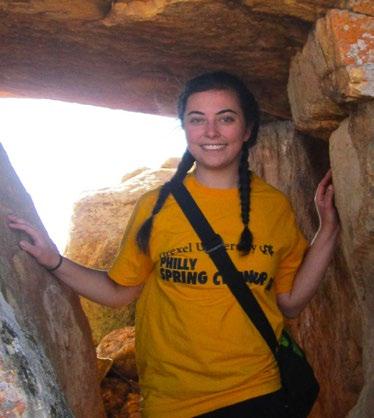
Mennano is a student in Dornsife’s accelerated Bachelor of Science/Master of Public Health (BS/MPH) 4+1 program.
At Dornsife, Mennano has not only become a well-rounded, high-achieving student, but she has also been able to pursue global learning experiences. The summer after her freshman year, she applied to the Dornsife Global Development Scholars program and earned a placement in Lesotho, a tiny country of 2,000, completely enveloped by South Africa. Mennano spent three months there working with World Vision, an NGO, studying drought and disease.
“We were able to talk to community leaders about interventions they employed, like putting caps on household water use,” Mennano said. “We talked about having World Vision with the communities to install some sort of infiltration system.”
Finding better ways to irrigate crops more efficiently and trying to make interventions that were “very much grounded at the community level” were some of the goals of the project there, Mennano said.
Mennano also spent three months in the field, closer to home, at the Philadelphia Department of Public Health, in the division of Maternal, Family, and Child Health. She was on a team that conducted a Zika surveillance system, tracking women who were infected and tracking children for several months afterward. Of all the infants they followed with Microcephaly, a condition where the head circumference is smaller than normal and that can be caused by a variety of factors, including the Zika virus, they found that none were ultimately related to Zika.
“I feel like I live in Philadelphia and understand the community,” Mennano said about her time at Philadelphia’s Department of Public Health and her time at Dornsife in general.
“Dornsife does such a good job of helping you find connections,” Mennano said. “A lot of the programming that Dornsife does is all very much grounded and rooted in social determinates of health and that health is a human right. That’s something I’ve been able to dig a lot deeper into since I’ve been at Dornsife.”
For her outstanding work with the Philadelphia Department of Public Health, Mennano was one of 10 students to receive a Cooperative Education Award from Drexel.
As for the future, Mennano will pursue a master’s degree in epidemiology with a minor in infectious diseases.
Her ideal job: “I really want to work with global disease outbreaks, essentially stopping another coronavirus outbreak,” Mennano said. “This has been such an invaluable experience living public health instead of just learning it. Just recognizing our role as people who are able to educate and spread health messages, right now we all have our part to play.”
55 20 20 VOL/
BS, MPH ’21
DORNSIFE
Highlights STUDENT
Josh Dossick
PROVIDING VITAL SERVICES
DURING THE PANDEMIC IN NYC
Little did Josh Dossick, MPH ’20, realize last winter as he approached his graduation from the Dornsife School of Public Health that he would be thrust into the middle of a pandemic in his new job, immediately putting the education he received at Dornsife to the test.
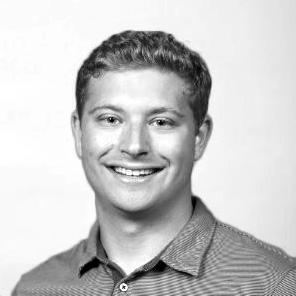
Dossick is an emergency management consultant in New York City with Hagerty Consulting, a firm that helps clients prepare for and recover from disasters. Hired by the firm to support pandemic response operations throughout NYC, they had Dossick hit the ground running, trusting that he already had the tools he needed from his experiences through Dornsife to be successful in his new position.
“Dornsife was able to give me connections into different work experiences in emergency management,” Dossick said. “Those experiences helped me land the job I have now. I don’t think if I hadn’t had those that I would be able to get this job…I had a baseline of knowledge that I wouldn’t have had without the experiences I got through Dornsife.”
At Dornsife, Dossick minored in public health emergency preparedness. And through the classwork and outside real-life work experiences, he was able to gain the knowledge and skills he has needed to make him successful in his new role helping with food distribution across NYC during COVID-19.
Dossick is a member of the team supporting an operation that is bringing food to people’s doors that need it. He works in an operation center that manages approximately 10 food distribution centers across the city, supporting those sites, helping with logistics and the
supply chain, “making sure everything goes where it’s supposed to in a bunch of different ways,” Dossick said.
Dossick had an internship at the Philadelphia Department of Public Health (PDPH), as well as a fellowship at the Philadelphia Office of Emergency Management. His integrated learning experience at Dornsife was with the PDPH, helping them codify their emergency management plans for ambulatory services for its qualified health center networks.
Dossick said he spent time talking to people who had worked at the PDPH over the years about emergency service plans and documented that institutional knowledge. He assisted in “developing an emergency management plan that would be used by the city and be available for an emergency if it occurs, like this one,” Dossick said.
All of this experience, in addition to his Dornsife coursework in which he examined case studies such as the SARS outbreak in 2003, helped Dossick quickly understand how he could fit into New York City’s COVID-19 relief efforts and support a massive food distribution operation.
“People who were unable to leave their homes because they’re highly vulnerable were in need,” Dossick said. “So, normally they would go to a food bank or food pantry, but now they’re isolated. This program was developed to get food delivered to those people safely.”
Before Dossick went to Dornsife to study public health, he had been working in information technology consulting. “I didn’t enjoy the work so much and felt like every day I wasn’t making a tangible impact,” he said.
“I found my way to public health, and now, at this job, I really enjoy going to bed at night and thinking how I helped to serve half a million meals in a day,” Dossick continued.
“It’s an unprecedented situation going on, and to be able to be involved in helping those people who are really struggling with this has been really rewarding for me and really fulfilling, which is exactly what I was going for when I quit my old job and went back to school for public health.”
56
MPH ’20
“People who were unable to leave their homes because they’re highly vulnerable were in need . So, normally they would go to a food bank or food pantry, but now they’re isolated.
Highlights ALUMNI DORNSIFE
T his program was developed to get food delivered to those people safely.
“
Elina Paul
data for the entire hospital is upto-date and entered in a timely manner so all units and parts of the entire hospital can see where we’re at with infection rates,” Paul said.
In support of the Infection Preventionists, Paul supports the team’s preparations for outbreak and exposure response and explores how the team can use data analytics tools for contact tracing.
TRACING INFECTION RATES DURING A PANDEMIC
“If we had a patient who was a potential chicken pox case, I would use data tools to help our Infection Preventionists identify if any patients or staff may have been potentially exposed.”
“We assure the appropriate isolation precautions were in place, and that the correct personal protective equipment (PPE) was worn by healthcare providers to identify if there was any risk of transmission,” Paul said.
all the different departments within the large facility to gather the information her department needs for reporting.
Paul’s team is letting the analysts know what fields of information the government is asking for. Then the analysts are able to use code to take the data from CHOP to pull it into apps that create tables for those who need to access it. The data is refreshed every day, Paul explained.
Elina Paul, MPH ‘19, had only been working in the Department of Infection Prevention and Control at Children’s Hospital of Philadelphia (CHOP) as an infection prevention associate for several months before the COVID-19 pandemic began.
“The best part about what I do is being able to be a public health professional in this time,” Paul said. “I can’t imagine experiencing [the pandemic] with any other team, honestly, because my team has been so amazing and so proactive. The work that we’re all doing is definitely important and meaningful.”
Before COVID-19, Paul’s job involved a bit less urgency, but was critical to the hospital’s functioning. As an infection prevention associate, she supports the Infection Preventionists by performing surveillance for, and mandatory reporting of, healthcare associated infections as well as responding to other infection prevention data requests.
“As well as helping identify these infections, my team and I also track and ensure that the
But since the COVID-19 outbreak, Paul’s job has shifted. “It’s been quite the learning experience,” she said.
Paul’s personal responsibilities as an infection prevention associate have been to help the Infection Prevention team’s COVID-19 response by performing additional surveillance and reporting, including mandatory reporting to local, state, and federal governments about the hospital’s pandemic response.
Paul has been partnering with the hospital’s emergency preparedness team, working closely with them to complete the local, state, and federal reporting. Paul has also been collaborating with the Center for Health Care Quality Analytics team within CHOP to build out automated data pulls and dashboards to help with the reporting, instead of having to manually call
“This type of work has always been something that has interested me, which is why I was very excited when I accepted this job, and then a couple months later, I’m experiencing a pandemic,” Paul said. “Part of the reason why I decided to get my MPH was to learn more about containing outbreaks, exposures, and vaccine preventable diseases.”
The faculty at Dornsife was very skilled at making sure she had the experiences and opportunities she was seeking, Paul added.
“I really wanted to make sure that I had a thesis experience that was going to help me with my career and actually mean something,” Paul said. She wound up writing her thesis about vaccine policy in Philadelphia, after an internship at the Philadelphia Department of Public Health.
“Their engagement with the students is something that I really admired,” Paul said about the Dornsife faculty and staff. “You weren’t just another number to them. They wanted to make sure that you got what you needed out of the experience.”
The work she did while at Dornsife also helped her land a job at CHOP — an opportunity too good to pass up, Paul said.
“While it is a very scary time, it is providing me with a really great learning experience.”
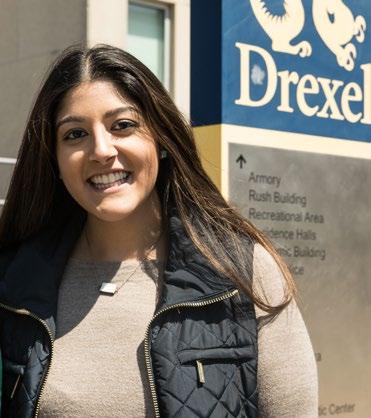
57 20 20 VOL/
MPH ’19
“Part of the reason why I decided to get my MPH was to learn more about containing outbreaks, exposures, and vaccine preventable diseases.”
Alex Ezeh, PhD
Professor of global health in the department of Community Health and Prevention
STRENGTHENING DORNSIFE’S COMMITMENT TO GLOBAL HEALTH IN AFRICA
When Alex Ezeh, PhD, became professor of global health in the department of Community Health and Prevention at the Dornsife School of Public Health two years ago, he brought along his vast background in research, strengthening research capacity, and policy advocacy on a range of global health and development issues.
Ezeh arrived at Dornsife from the African Population and Health Research Center (APHRC), where he spent 17 years as the founding executive director. He guided APHRC to become one of Africa’s foremost research centers in addressing population, health, education, and development issues. While at APHRC, Ezeh created and led the Consortium for Advanced Research Training in Africa (CARTA), an initiative to strengthen doctoral training and the retention of academics at African universities.
Ezeh said there are three main goals to his work: examining the drivers of rapid population growth and designing interventions that could limit or affect the rate of growth of populations; thinking about how to “best design
programs and policies to improve the well-being” of those who live in slums around the world; and creating stronger research entities and institutions in Africa, “to be more active in identifying and delivering knowledge that creates transformative change on the continent,” Ezeh said.
“One of the things that drew me to Drexel when I decided to come here was that at the university, I saw a commitment to global engagement that they had within the school of public health,” Ezeh said. “As Drexel continues to expand its global engagement, I hope this is an area I can contribute to and support.”
Ezeh strives to work with young researchers, particularly at the doctoral level, who come from groups who are underrepresented in health research. “I work with them to support them and help them develop some of the skills they need…locally, in the U.S., and in Africa and Latin America,” he said.
While at APHRC, Ezeh developed a number of training programs for doctoral candidates across sub-Saharan Africa, graduating 450 PhDs and more than 100 post-docs across the continent over the past 12 years, he said. “And the good thing is that many of these individuals are now research leaders on the continent, which is really great.”

58
Highlights FACULTY DORNSIFE
“We know that the number of [COVID-19] cases in Africa is very low, but we do not know if it is because the [pandemic] has not really reached ther e, or if the reporting has been very effective at all.”
Across much of Europe, the average age is approximately 48 and the average age of most who have died from COVID-19 is somewhere in the 80s; whereas in Africa, the median age is 18 and only three percent of the population is 65 years or older
His connection with Africa provides an opportunity to bring on board more students from the continent to come to Drexel for their training and then return to Africa to do their work. “You can only do that if the university is engaged and better known, and people can connect with it easily,” Ezeh said, explaining one of his goals for his work at Dornsife.
In addition, Ezeh focuses on addressing the challenges that come with the growth of slums around the world and the continuing rapid population growth in sub-Saharan Africa. He has highlighted the developmental implications of sub-Saharan Africa’s population and urbanization trends, underscored the unique vulnerabilities slum populations face, defined the systems (education, health, economic, etc.) that best serve slum populations, and has ensured slum populations become more visible in national and global reports and data systems.
Right now, Ezeh is also engaged in seeking a grant in partnership with researchers in Canada and across different African countries to look at the prevalence of COVID-19 antibodies in Africa.
“We know that the number of cases in Africa is very low,” Ezeh said. “But we do not know if it is because the [pandemic] has not really reached there, or if the reporting has been very effective at all.”
Median age may be playing a role in the pandemic’s course through Africa, Ezeh said.
For instance, across much of Europe, the average age is approximately 48 and the average age of most who have died from COVID-19 is somewhere in the 80s; whereas in Africa, the median age is 18 and only three percent of the population is 65 years or older, Ezeh explained.
“The question for us that we are asking is, ‘Is it the population structure that is limiting the impact of the virus?’” Ezeh said. And if so, maybe “being in lockdown for the entire population is not the best policy option given the economic consequences of the lockdown.”
Being able to carry out this study, tracking COVID-19 antibodies in Africa, would offer a “huge contribution to the policy” decisions that are carried out, Ezeh said.
LEADERSHIP
Ana V. Diez Roux, MD, PhD, MPH
Dean and Distinguished University Professor of Epidemiology
Jennifer Kolker, MPH
Associate Dean for Public Health
Practice and External Relations Clinical Professor, Health Management and Policy
EDITOR Emily Gallagher
CONTRIBUTORS
Courtenay Harris Bond • Karyn L. Feiden •
Alissa Falcone • Sarah Greer •
Jon Krause • Natalie Hope McDonald •
James Olstein • Greg Richter •
Don Sapatkin • Renee Wagoner
PRODUCTION & DESIGN Page 33 Studio
PHOTOGRAPHY
Jeff Fusco • Margo Reed • Rachel Wisniewski
FEEDBACK?
Send your comments on the magazine to dsphweb@drexel.edu.
drexelpubhealth
drexelpublichealth
drexelpubhealth
linkedin.com/school/11204281
drexelpublichealth
To keep up with more Dornsife news, visit drexel.edu/Dornsife
59 20 20 VOL/
2020 VOL/
Highlights Amid the Pandemic
The year of 2020 has been like no other. Despite many uncertainties, the Dornsife community has had happy moments worth sharing.
Shannon Kelleher @shannonkelle
“Graduating with a Masters of Public Health and entering the workforce in the middle of a pandemic like

Thanks to all the friends, family and colleagues who helped me make it through my program and supported me during the first 5 months of my post Masters career. We are living through a time of great uncertainty in public health but with the right guided efforts this can also be a time of valuable and long overdue change.”
#drexelgrad

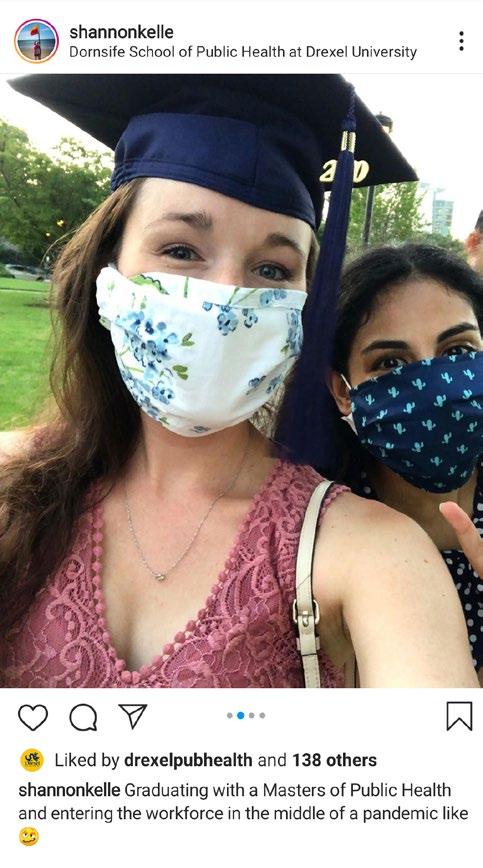
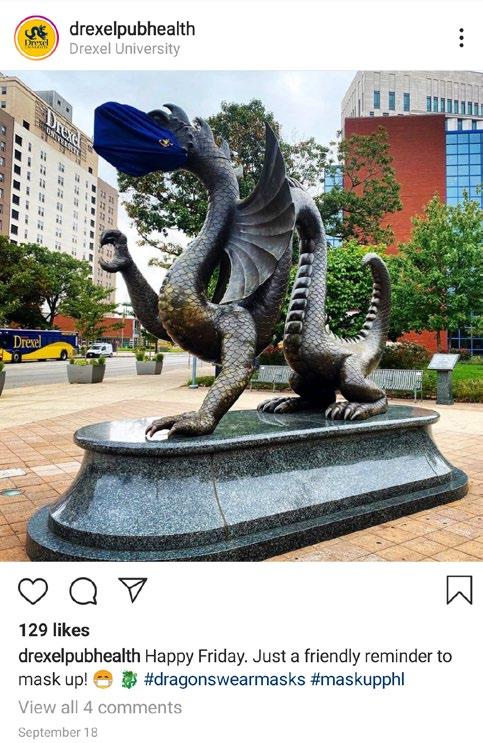
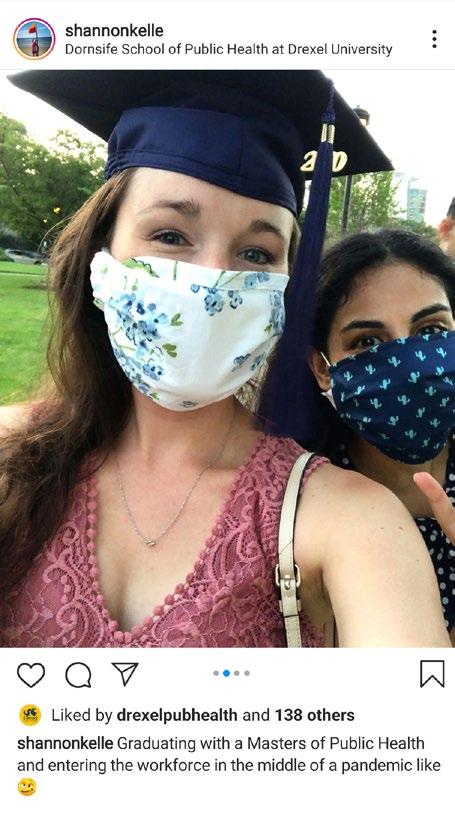
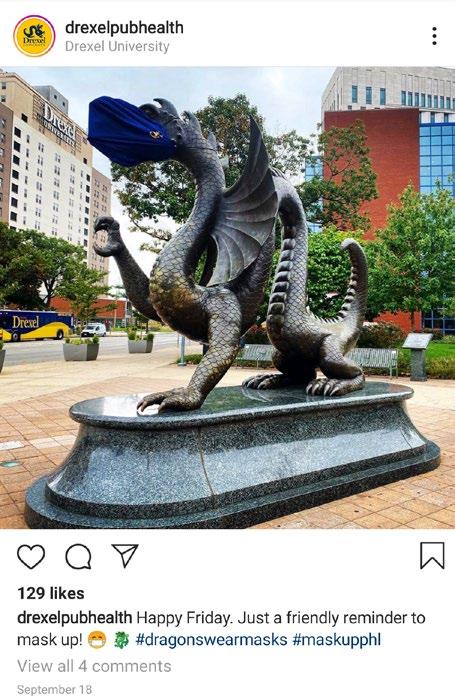
Dornsife School of Public Health

@drexelpubhealth
“Happy Friday. Just a friendly reminder to mask up!”
#dragonswearmasks

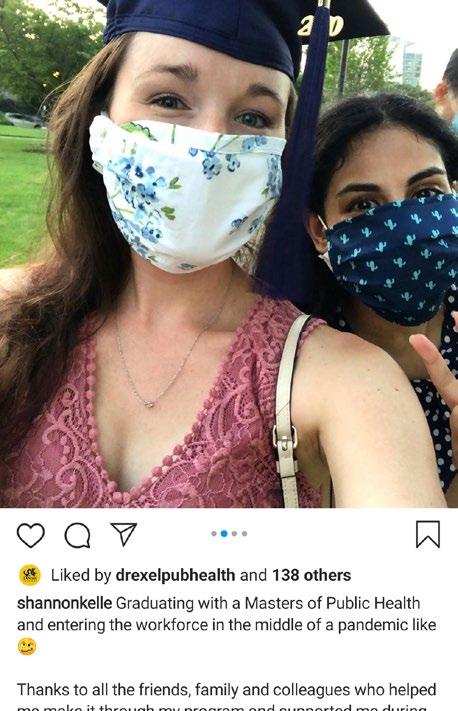
#maskupphl


 Damian Dodge @tazdamiandevil
Damian Dodge @tazdamiandevil
“1st day of 17th grade!
#gradschool

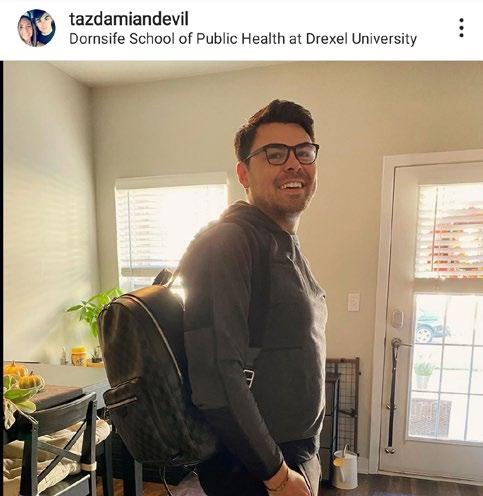
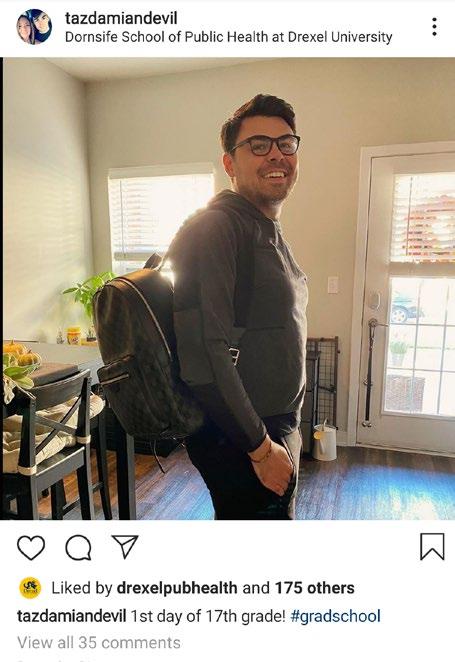
60 SCROLL CALL
20 20 VOL/
URBAN FOCUS. GLOBAL IMPACT.
For more than two decades, the Drexel Dornsife School of Public Health’s research programs and centers have uncovered surprising truths that have challenged convention. Just as importantly, our research has inspired change in urban and global health policy and practice. Because it’s not enough to know the answers to public health’s toughest questions—we must act on them.

MORE ABOUT DREXEL DORNSIFE’S WORK. DREXEL.EDU/DORNSIFE
OUR CHALLENGE LEARN

Nesbitt Hall
Market Street
19104 Non-Profit Org. U.S. Postage PAID Permit #144 Philadelphia, PA
252
3215
Philadelphia, PA













 James Olstein illustrator / jamesolstein.com
James Olstein illustrator / jamesolstein.com





















































 Damian Dodge @tazdamiandevil
Damian Dodge @tazdamiandevil














